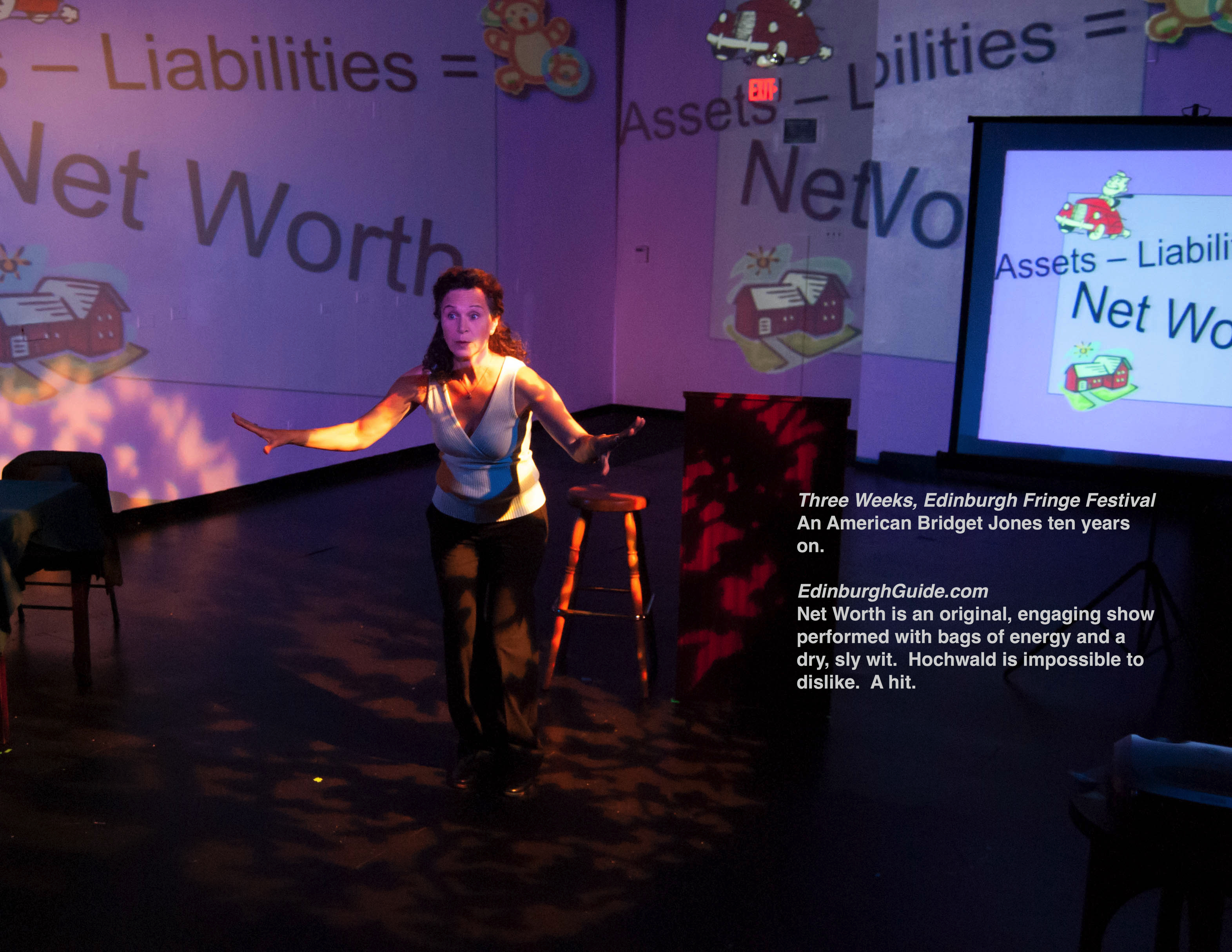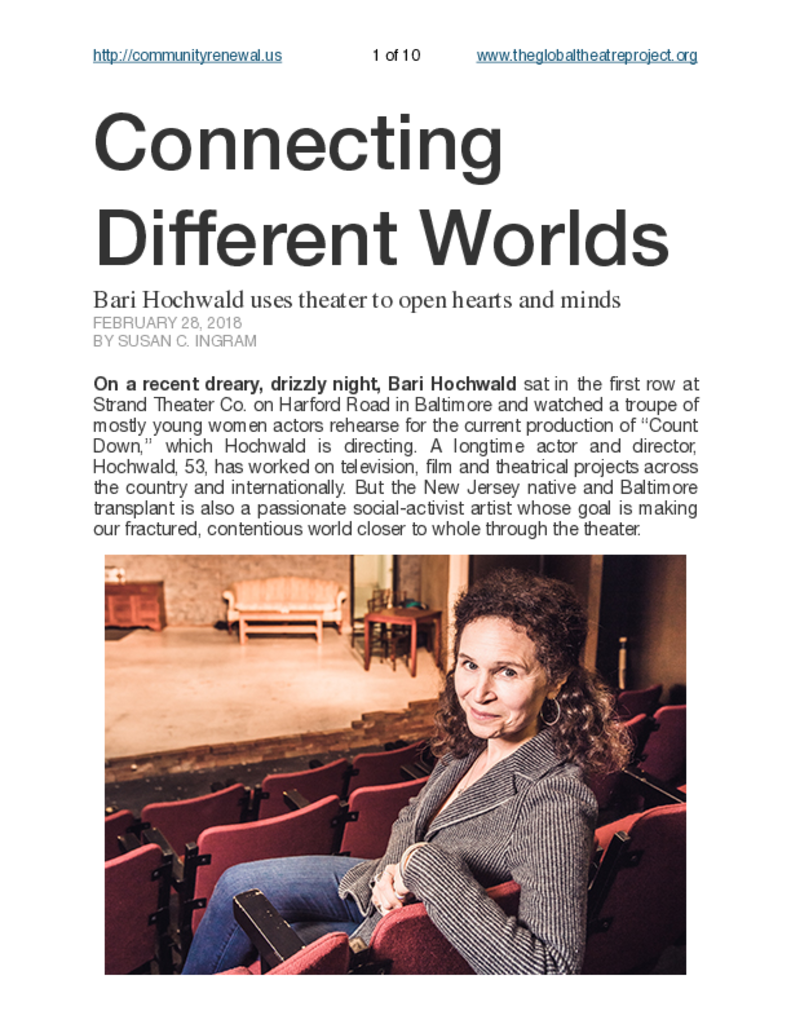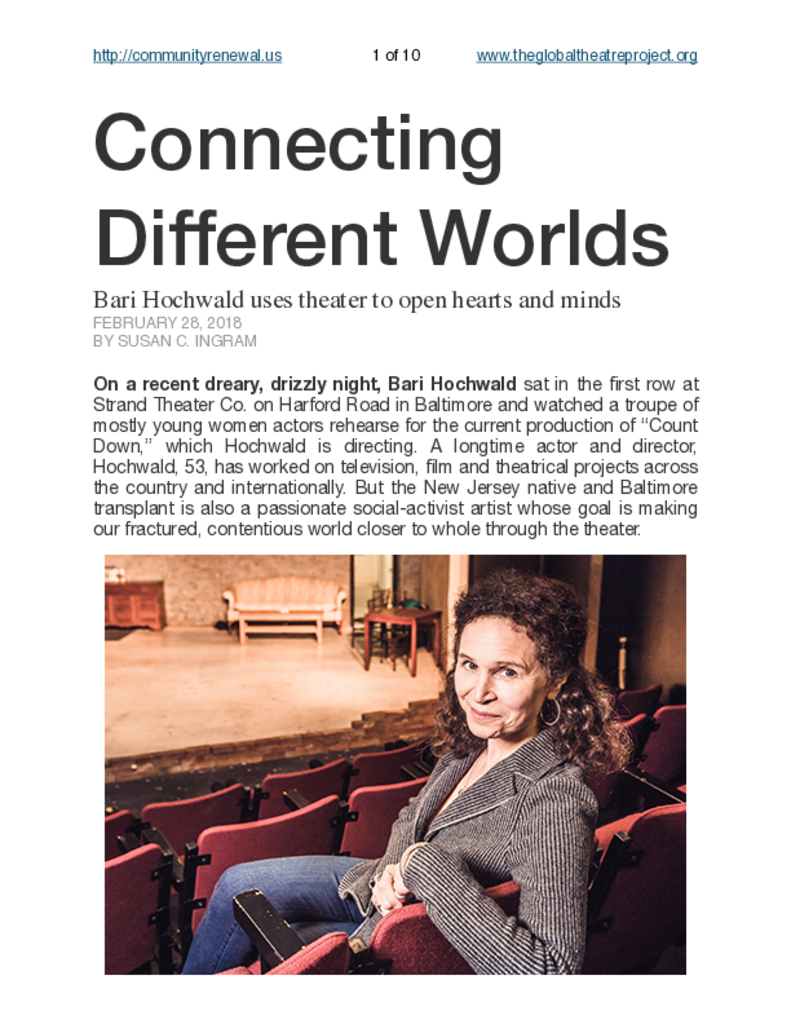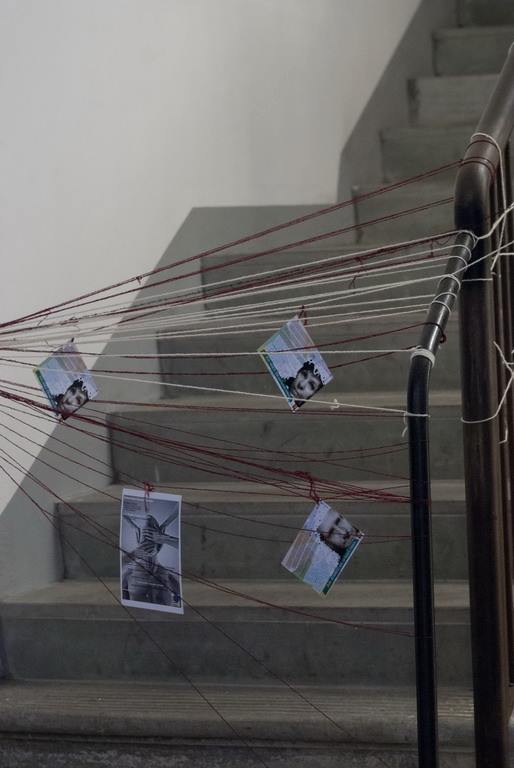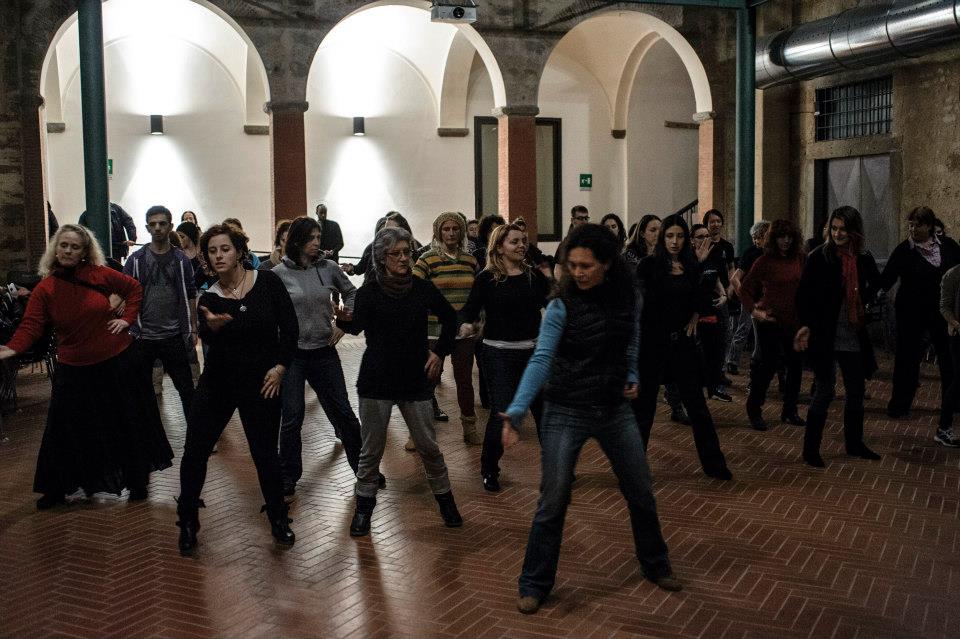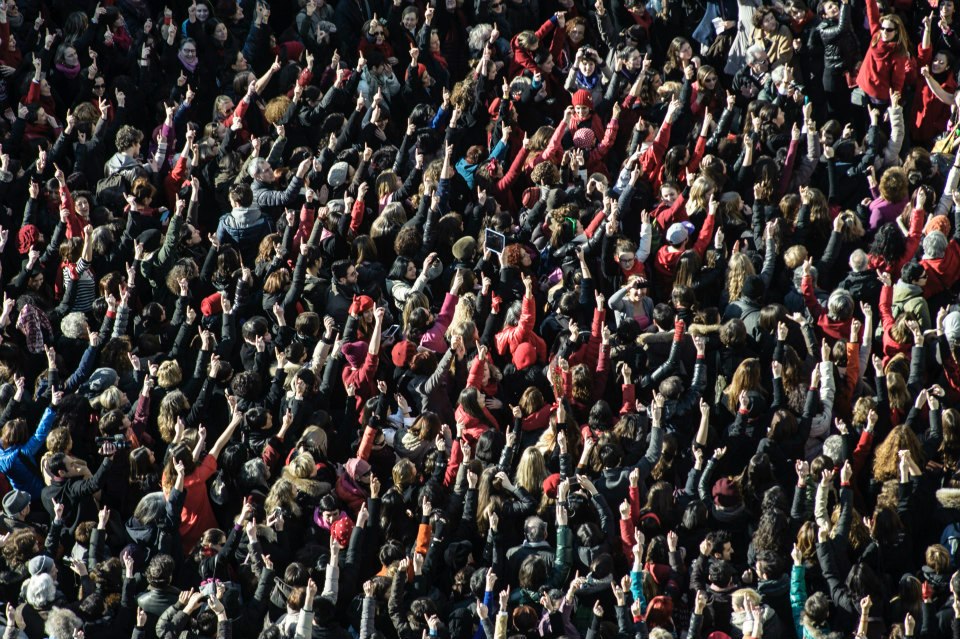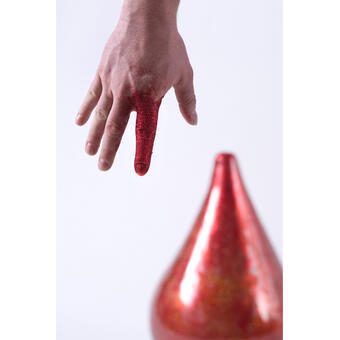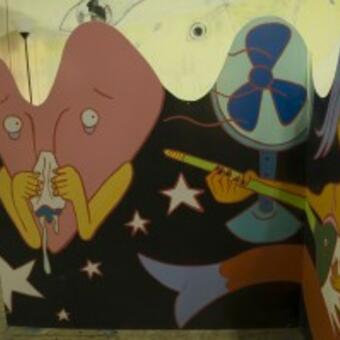Work samples
-
My Heart: Why The Global Theatre ProjectThe Global Theatre Project, founded in 2011, reflects all my concerns artistically and socially. I make theatre to celebrate the beauty of humanity. But I do it by looking honestly at some of the horrors we currently create. Because I know we are more than this, I develop collaborative processes and live events to encourage us to think, feel and act justly with one another.
-
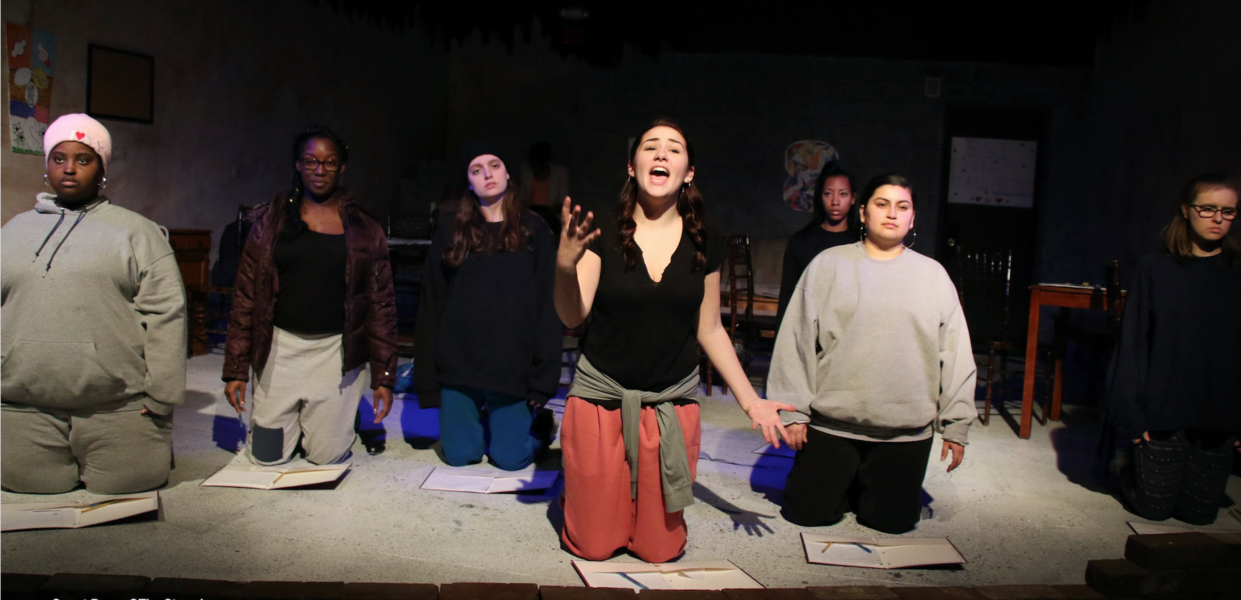 Directing @The Strand, BaltimoreI directed and choreographed Dominique Cieri's "Count Down" at The Strand Theatre, Baltimore utilizing mask, spoken word, movement and narrative to explore and celebrate stories of young girls lost in our institutions. "the girls, one after another, unmask their traumatic histories to swirling, stomping, slow-motion choreography. Director Bari Hochwald masterfully stages the action throughout the play." - DC Metro
Directing @The Strand, BaltimoreI directed and choreographed Dominique Cieri's "Count Down" at The Strand Theatre, Baltimore utilizing mask, spoken word, movement and narrative to explore and celebrate stories of young girls lost in our institutions. "the girls, one after another, unmask their traumatic histories to swirling, stomping, slow-motion choreography. Director Bari Hochwald masterfully stages the action throughout the play." - DC Metro -
 Belarus Dream TheatreWith this piece I continued my experimentation with the audience's relationship to the performer. Particularly on work that was asking imperative social questions. Belarus Dream Theatre was bringing attention to the question of censorship in a democracy - in this case, Belarus - but it was important for me that the audience understood we are all under scrutiny. We are all vulnerable. So I didn't want them to sit comfortably in the dark. I put the performers in the audience, we had young community members sit as audience with their mouths gagged and we added two men in black with cameras on their heads who moved throughout the play recording everything. Additionally, Amnesty International was our partner, there to answer questions at the end of the event. I included many various community partners, and we engaged multiple disciplines into a week-long exploration which culminated in this performance.
Belarus Dream TheatreWith this piece I continued my experimentation with the audience's relationship to the performer. Particularly on work that was asking imperative social questions. Belarus Dream Theatre was bringing attention to the question of censorship in a democracy - in this case, Belarus - but it was important for me that the audience understood we are all under scrutiny. We are all vulnerable. So I didn't want them to sit comfortably in the dark. I put the performers in the audience, we had young community members sit as audience with their mouths gagged and we added two men in black with cameras on their heads who moved throughout the play recording everything. Additionally, Amnesty International was our partner, there to answer questions at the end of the event. I included many various community partners, and we engaged multiple disciplines into a week-long exploration which culminated in this performance.
About Bari
Baltimore City
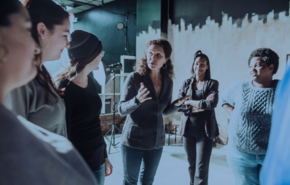
Bari Hochwald-Cagnola is a theatre director, performer, and curator of theatrical community-engaged events. She is Founder and Artistic Director of The Global Theatre Company originally established in Florence, Italy and Los Angeles, CA in 2011. Her work is inspired by her eclectic training - as a performer first studying an Actors Studio-based foundation at Syracuse University under Arthur Storch and then as a part of the first graduating class of the American Repertory Theatre Institute for… more
Jump to a project:
Performance: Acting
Having started my career as an actress, I worked in theatres across the nation with directors such as Anne Bogart, Andrei Serban, Anthony Zerbe and Joe Bologna and actors including Josh Brolin, Ed Harris, James Cromwell and Cherry Jones. Because of such a broad exposure, my approach to performance has always been eclectic and a mix of methodologies. Working in front of the camera with actors including William H. Macy, Matthew Fox and Tyne Daly was where I learned about intimacy, specificity and patience.
At this point in my career I define myself as a theatre artist and still enjoy performing. But the consciousness I bring to my performances includes an understanding of the event itself - the relationship between myself, the other artists, and the audience as a communal and valuable event. That the celebration of our humanity through shared storytelling can contribute something of worth to our society.
I believe that my performance experience shapes my approach to directing and to creating community-engaged events. Without this background and foundation I would be a different type of artist.
At this point in my career I define myself as a theatre artist and still enjoy performing. But the consciousness I bring to my performances includes an understanding of the event itself - the relationship between myself, the other artists, and the audience as a communal and valuable event. That the celebration of our humanity through shared storytelling can contribute something of worth to our society.
I believe that my performance experience shapes my approach to directing and to creating community-engaged events. Without this background and foundation I would be a different type of artist.
-
 Net WorthNet Worth, one woman show which follows a relatively traditional play structure, I wrote over the course of two years workshopping it in Los Angeles, CA. For the following ten years I then performed Net Worth to strong reviews and audience response in Syracuse, NY; Edinburgh, Scottland; Florence, Italy; Los Angeles, Anaheim, CA; and lastly Baltimore at the Strand Theatre to open its new home on Harford Road.
Net WorthNet Worth, one woman show which follows a relatively traditional play structure, I wrote over the course of two years workshopping it in Los Angeles, CA. For the following ten years I then performed Net Worth to strong reviews and audience response in Syracuse, NY; Edinburgh, Scottland; Florence, Italy; Los Angeles, Anaheim, CA; and lastly Baltimore at the Strand Theatre to open its new home on Harford Road. -
 Net WorthThe play moved instantaneously between giving a workshop to the audience on personal finances and thoughts and memories enacted through 9 characters that are triggered in the character's head about her own 'net worth.' I used my father's artwork of digitally-created abstracts to establish and reflect mood and to also honor his presence as the piece speaks to value of family legacy and he had passed away only a couple of years prior.
Net WorthThe play moved instantaneously between giving a workshop to the audience on personal finances and thoughts and memories enacted through 9 characters that are triggered in the character's head about her own 'net worth.' I used my father's artwork of digitally-created abstracts to establish and reflect mood and to also honor his presence as the piece speaks to value of family legacy and he had passed away only a couple of years prior. -
 Net WorthThe internal dialogue of this piece reflected the questioning of self-value and our place in the world that we each experience in one way or another. The humor of the show and the fun of performing it was that on a drop of a dime I was composed teaching about assets and liabilities and then got to switch immediately into neurotic trauma or passionate recall. Because I wrote this piece, I created something that was a joy to do, stretched me and used all of my performance abilities.
Net WorthThe internal dialogue of this piece reflected the questioning of self-value and our place in the world that we each experience in one way or another. The humor of the show and the fun of performing it was that on a drop of a dime I was composed teaching about assets and liabilities and then got to switch immediately into neurotic trauma or passionate recall. Because I wrote this piece, I created something that was a joy to do, stretched me and used all of my performance abilities. -
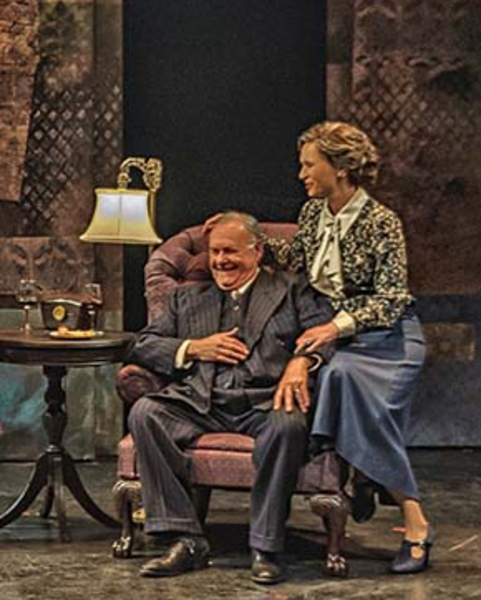 @Everyman - Book of JosephWith Wil Love. This play was enacting a real historic event, and I find an extra weight and responsibility when embodying a character who had lived, especially one who came to a violent end. The issues brought up in the play - immigration and anti-semitsm - were particularly potent in our political world at that time and I was well aware the audience would make those connections. This was an added element taken into account regarding the structure of two of the characters I developed.
@Everyman - Book of JosephWith Wil Love. This play was enacting a real historic event, and I find an extra weight and responsibility when embodying a character who had lived, especially one who came to a violent end. The issues brought up in the play - immigration and anti-semitsm - were particularly potent in our political world at that time and I was well aware the audience would make those connections. This was an added element taken into account regarding the structure of two of the characters I developed. -
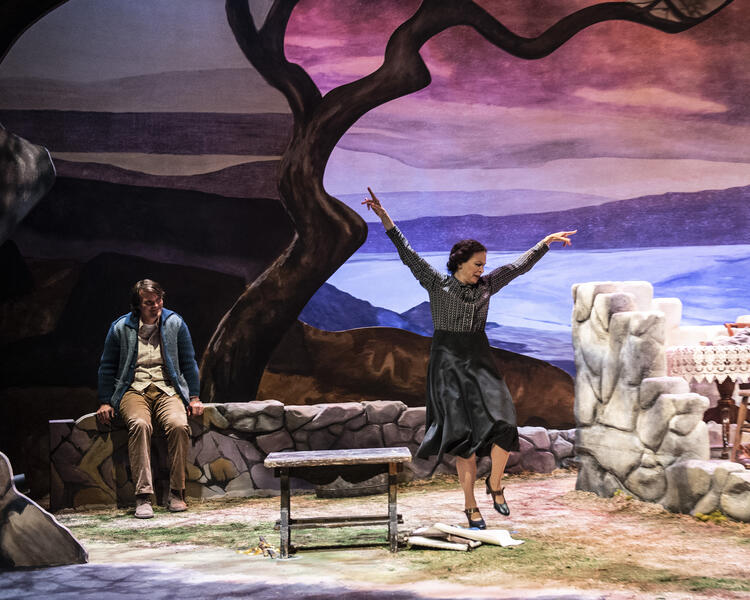 @Everyman - Dancing At LughnasaThe challenge of Kate was to play someone who has tried her whole life to do everything right. But who is deeply unhappy and unable to acknowledge her unhappiness as she holds everything together for her family out of a sense of duty. To find that and be sure all her levels are within her soul, not played out, nor overly repressed, is the challenge and opportunity of this type of character.
@Everyman - Dancing At LughnasaThe challenge of Kate was to play someone who has tried her whole life to do everything right. But who is deeply unhappy and unable to acknowledge her unhappiness as she holds everything together for her family out of a sense of duty. To find that and be sure all her levels are within her soul, not played out, nor overly repressed, is the challenge and opportunity of this type of character. -
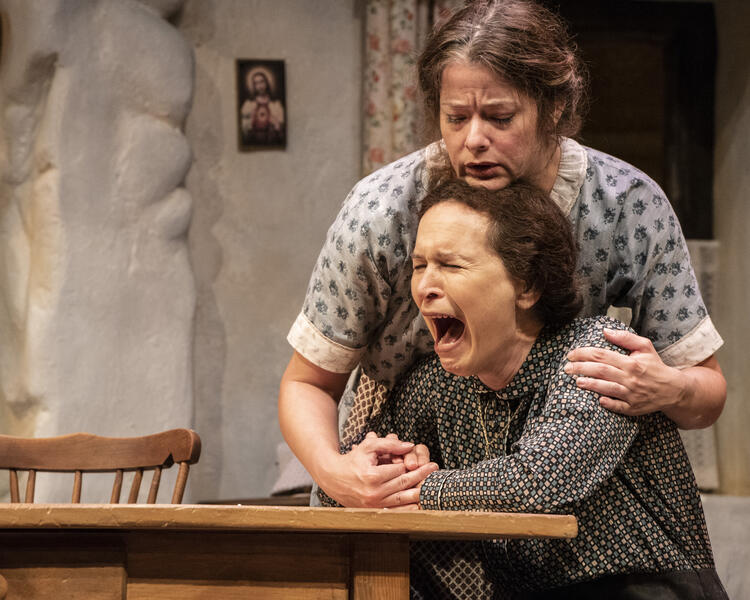 @Everyman - Dancing At LughnasaIt is a truth that no actor works alone or tells any full storyline or moment - even if they are the only one speaking for pages of text - without the partnership of those onstage with them. Megan Anderson gave so much in her listening and love that it allowed Kate to hear herself, and to free herself, for just a moment, of all her fear and pain.
@Everyman - Dancing At LughnasaIt is a truth that no actor works alone or tells any full storyline or moment - even if they are the only one speaking for pages of text - without the partnership of those onstage with them. Megan Anderson gave so much in her listening and love that it allowed Kate to hear herself, and to free herself, for just a moment, of all her fear and pain. -
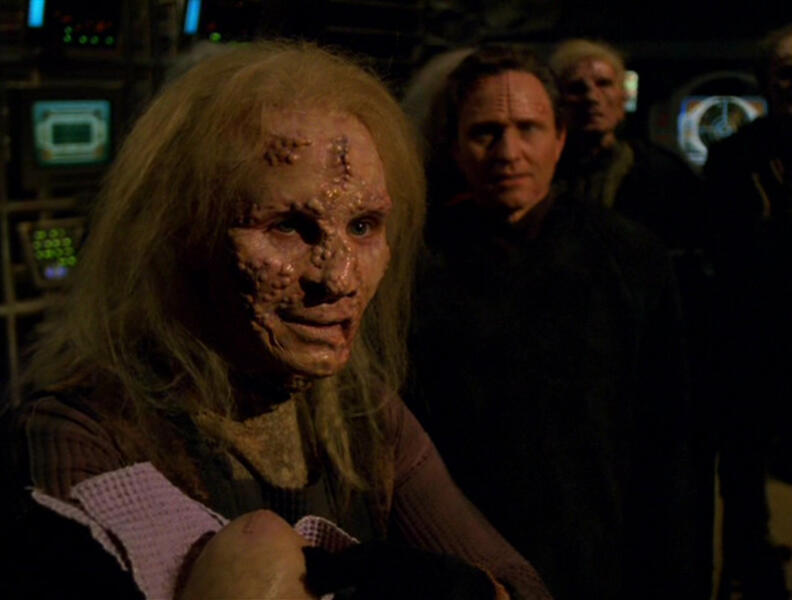 Star Trek: BrinAlthough my career started on stage, I had a ten year period working on television. I found the Star Trek family to be a comfortable place to work - in a role like this which was a pregnant mother exposed for years to nuclear waste and fearful for the life of her child to-be-born - the cast and crew was supportive in giving me the space necessary to play the moments fully. It was in comparing experiences from one set to another that I observed what good leadership requires to bring the best out of aritsts.
Star Trek: BrinAlthough my career started on stage, I had a ten year period working on television. I found the Star Trek family to be a comfortable place to work - in a role like this which was a pregnant mother exposed for years to nuclear waste and fearful for the life of her child to-be-born - the cast and crew was supportive in giving me the space necessary to play the moments fully. It was in comparing experiences from one set to another that I observed what good leadership requires to bring the best out of aritsts. -
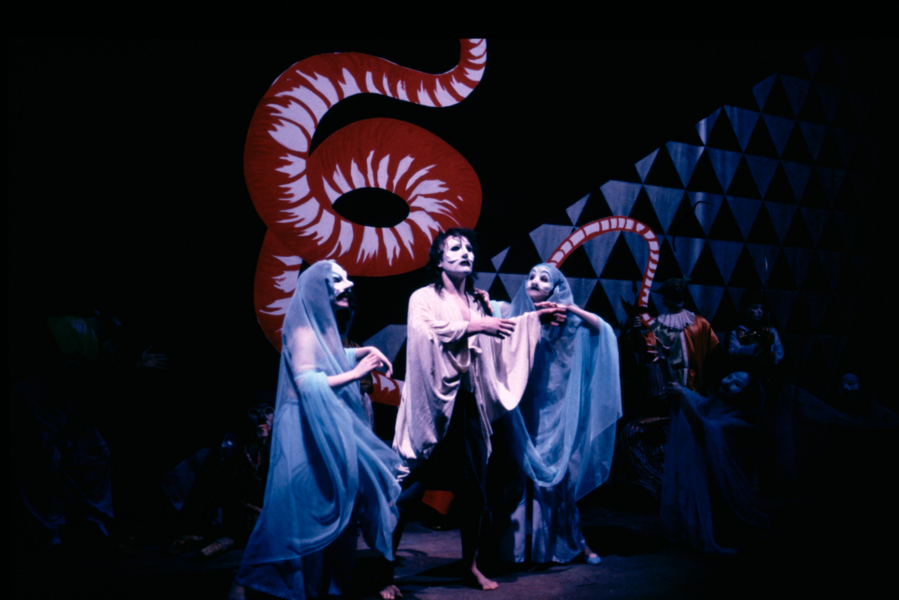 @American Repertory Theatre - The Serpent WomanAt A.R.T. where I trained in highly physical theatre. I also began to understand my place in the telling of the story, my responsibility to it regardless of the size of my role. I worked at this time with Anne Bogart who was developing her approach to the viewpoints, and came to know the work of Julie Taymor when I worked on the acclaimed King Stag directed by Andrei Serban. I understood the magic of theatre and its power when melded to truely authentic emotion and started a love affair with mask work.
@American Repertory Theatre - The Serpent WomanAt A.R.T. where I trained in highly physical theatre. I also began to understand my place in the telling of the story, my responsibility to it regardless of the size of my role. I worked at this time with Anne Bogart who was developing her approach to the viewpoints, and came to know the work of Julie Taymor when I worked on the acclaimed King Stag directed by Andrei Serban. I understood the magic of theatre and its power when melded to truely authentic emotion and started a love affair with mask work. -
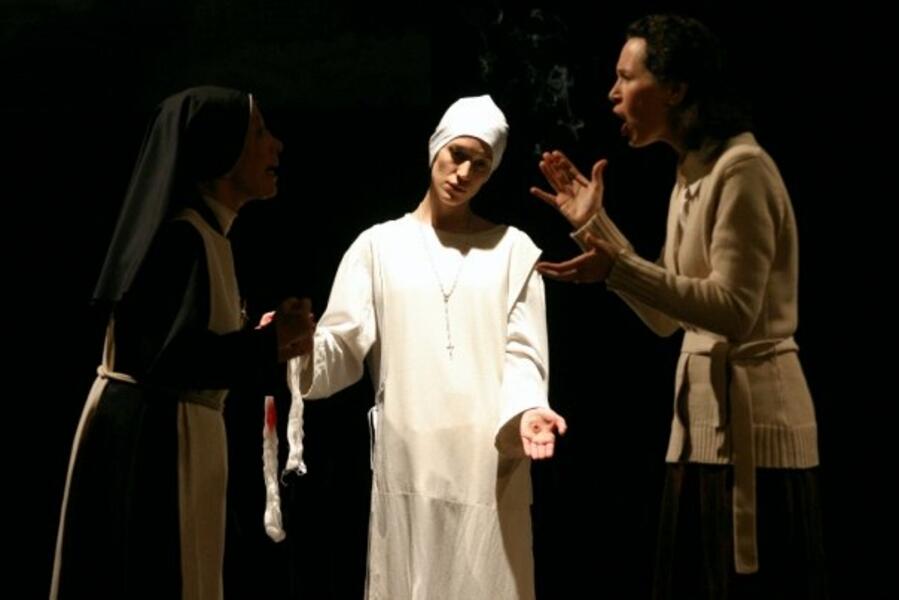 Florence International Theatre CompanyAs Artist Director of Florence International Theatre Company this was one of the last productions I acted in which I also produced. I have found that the freedom I need as an actor to fall deeply into my work is handicapped when I am also concerned about the printing of the programs or what is happening in front of the house. It was this period which moved me more into the area of directing where I was able to balance the production needs with that particular use of myself artistically.
Florence International Theatre CompanyAs Artist Director of Florence International Theatre Company this was one of the last productions I acted in which I also produced. I have found that the freedom I need as an actor to fall deeply into my work is handicapped when I am also concerned about the printing of the programs or what is happening in front of the house. It was this period which moved me more into the area of directing where I was able to balance the production needs with that particular use of myself artistically. -
Acting ReelThis reel includes work from when I was in Los Angeles as well as one clip from an award-winning short I did in Italy.
Count Down
Count Down, by Dominique Cieri is a play I was grateful to bring to Baltimore. Produced at the Strand, the production was a potent example of the commitment of young actors to powerful, complex and challenging material. The play followed a teaching artist's experience working with damaged and endangered girls in an institution in New Jersey. It was important that the performances were honest and raw. We kept the set very simple and worked entirely on relationship and need. The text incorporated spoken word, mask work, movement and dance along with a great deal of humor and drama. I was deeply proud of this cast who respected the actual girls they were representing by wrapping everything they had into their work. The love they developed both for their characters and each other was apparent at each performance.
-
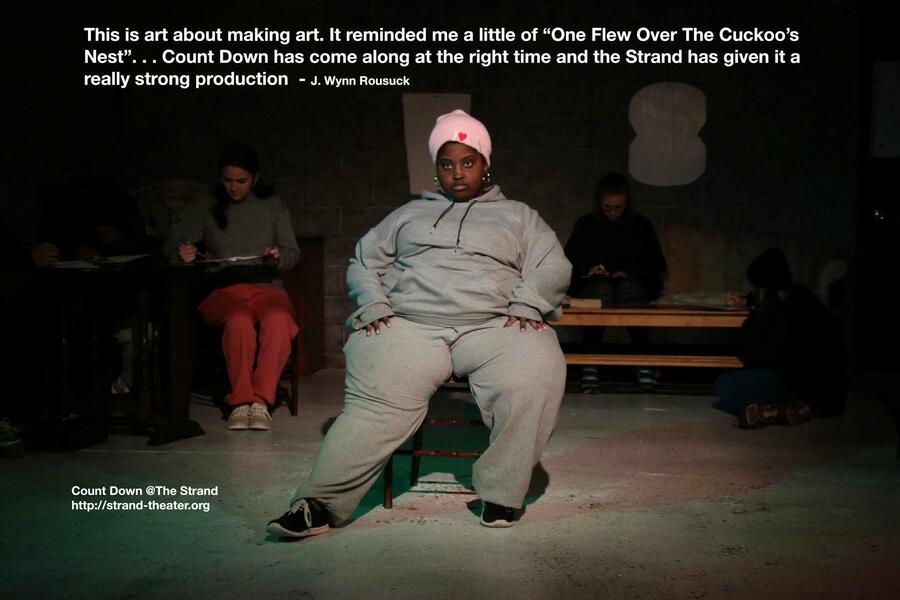 Count DownEvery character had a painful history. My job was to guide the actresses to center of their heart and allow enough of a sense of safety in the structure of the blocking for them to beat on the walls and tell their story when necessary.
Count DownEvery character had a painful history. My job was to guide the actresses to center of their heart and allow enough of a sense of safety in the structure of the blocking for them to beat on the walls and tell their story when necessary. -
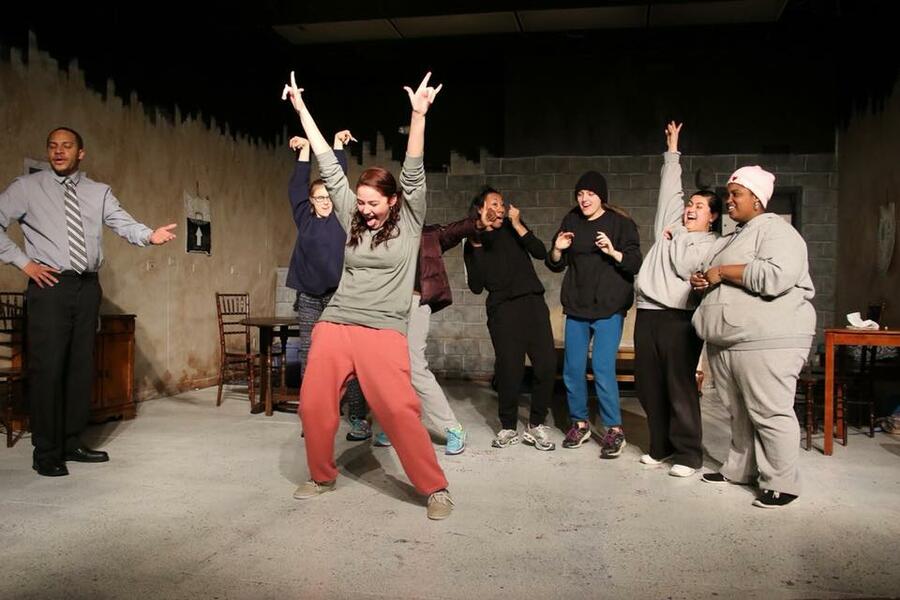 Count DownThe beauty of Count Down is that Cieri captures the true voice, energy and impulsiveness of seven teenage girls being locked up with their histories and their hormones. Placing that reality in a theatrical presentation in an intimate theatre such as the Strand gave me the opportunity to create a world where the audience was in the lap of this - oftentimes - chaotic normalcy.
Count DownThe beauty of Count Down is that Cieri captures the true voice, energy and impulsiveness of seven teenage girls being locked up with their histories and their hormones. Placing that reality in a theatrical presentation in an intimate theatre such as the Strand gave me the opportunity to create a world where the audience was in the lap of this - oftentimes - chaotic normalcy. -
Count DownThe masks were a tough logistical challenge for this production because they start blank, are worked on throughout the play and then emerge for the girls' final performance completed. This play was also about the process of art - how that can release truths and a sense of authority in a person. These masks needed to reflect that power in the unique way each was made, so I worked with a maskmaker to create the base of them, but wanted each actress to make her own mask in the process of rehearsal. I chose more of a primitive, tribal look because of the community those masks are often shared in, the cultural historic significance and the power.
-
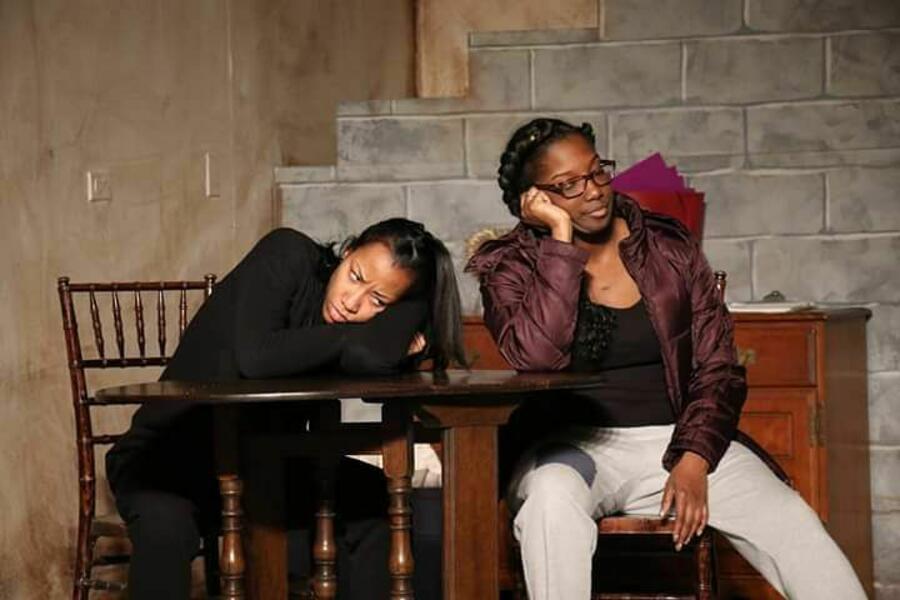 Count DownIo Browne and Zipporah Brown. I wanted to be sure the expression of highs and low were extreme as the inner lives of the characters. "The teenage girls are the standout stars of the show. From the performances of the actors playing the girls and the script’s heartbreaking monologues to the energetic, deliberate choreography, the production takes great care to show who these young women are." - DC Metro Theatre Arts
Count DownIo Browne and Zipporah Brown. I wanted to be sure the expression of highs and low were extreme as the inner lives of the characters. "The teenage girls are the standout stars of the show. From the performances of the actors playing the girls and the script’s heartbreaking monologues to the energetic, deliberate choreography, the production takes great care to show who these young women are." - DC Metro Theatre Arts -
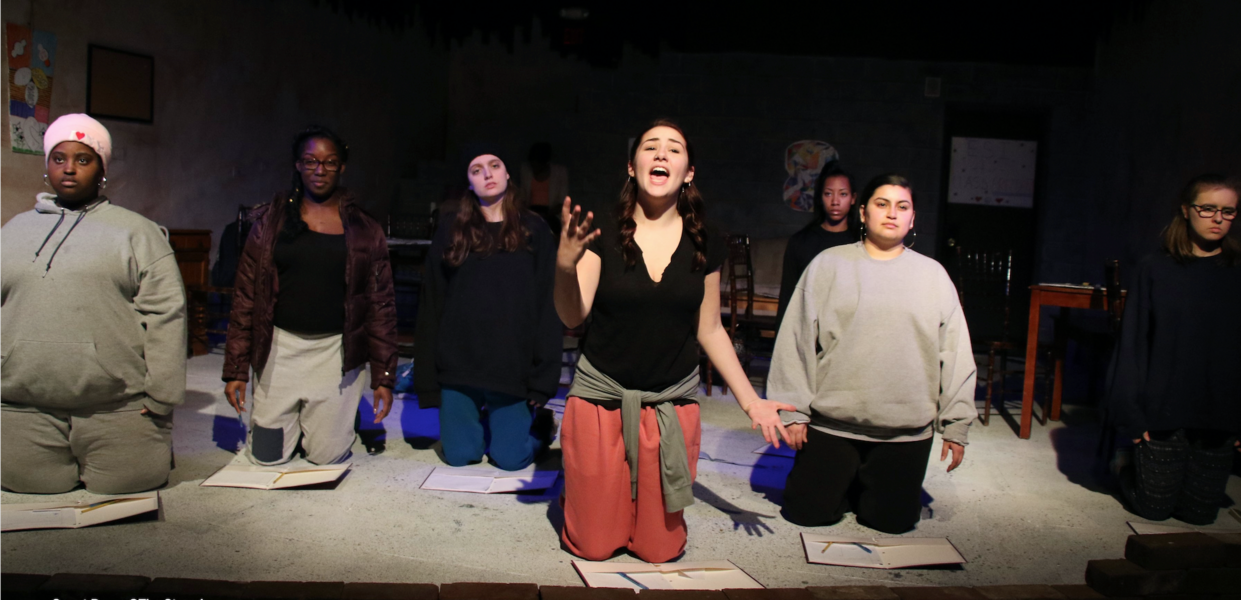 Count DownThe actresses' trust of the material and my direction is something I will always be grateful for. This production used all of my abilities - and it helped a great deal that I am also an actress, so that what was needed from these young women could be found through a process I understood from the inside.
Count DownThe actresses' trust of the material and my direction is something I will always be grateful for. This production used all of my abilities - and it helped a great deal that I am also an actress, so that what was needed from these young women could be found through a process I understood from the inside. -
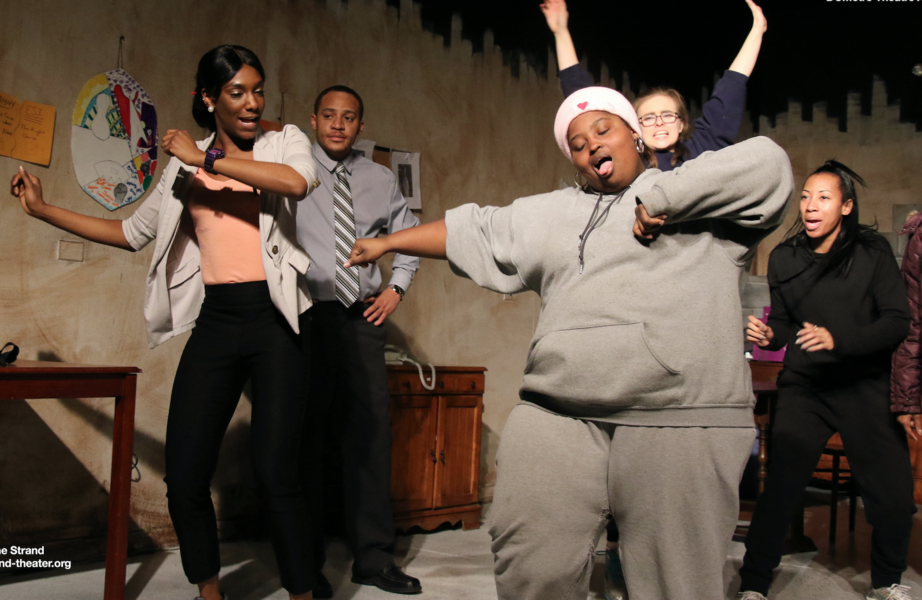 Count DownThe evolution of movement in this play was an intersting thing to design. From the 'spontaneous' to the choreographed we had to find what was authentic to both the teaching artist character (played by Brittany Timmons on the left) and to the girls. Their movement needed to come from what was occuring at the moment within their characters - as well as how they wanted or needed to manipulate the moment. The task was to turn that into beautiful choreography at the end - which was also expressive of their progress and the teacher's ability to shape it lovingly.
Count DownThe evolution of movement in this play was an intersting thing to design. From the 'spontaneous' to the choreographed we had to find what was authentic to both the teaching artist character (played by Brittany Timmons on the left) and to the girls. Their movement needed to come from what was occuring at the moment within their characters - as well as how they wanted or needed to manipulate the moment. The task was to turn that into beautiful choreography at the end - which was also expressive of their progress and the teacher's ability to shape it lovingly. -
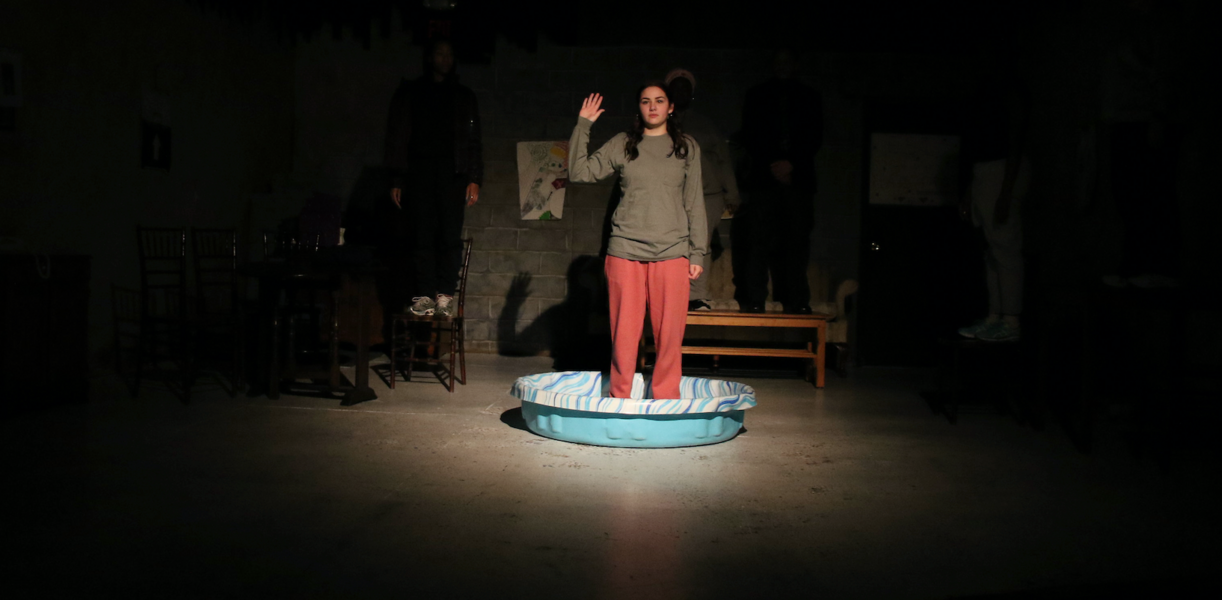 Count DownI am often interested in how to use simple objects and give them multiple significance. The playwright introduced a baby pool in the scene prior to the memory scene where several of the girls release their stories for the first time. I realized the opportunity for its use as a baptismal, as a place to hold their sins and the sins done to them, as a confessional - all within an innocent object identified with childhood and summer fun - would have a powerful signficance for the audience. "In an especially inspired scene the girls, one after another, unmask their traumatic histories to swirling, stomping, slow-motion choreography. Director Bari Hochwald masterfully stages the action throughout the play to which the young women bring bubbling energy and heartbreaking vulnerability." DC Metro Theatre Arts
Count DownI am often interested in how to use simple objects and give them multiple significance. The playwright introduced a baby pool in the scene prior to the memory scene where several of the girls release their stories for the first time. I realized the opportunity for its use as a baptismal, as a place to hold their sins and the sins done to them, as a confessional - all within an innocent object identified with childhood and summer fun - would have a powerful signficance for the audience. "In an especially inspired scene the girls, one after another, unmask their traumatic histories to swirling, stomping, slow-motion choreography. Director Bari Hochwald masterfully stages the action throughout the play to which the young women bring bubbling energy and heartbreaking vulnerability." DC Metro Theatre Arts -
 Count DownKylie Miller and George Oliver Buntin depicted the storyline which brought the real institution to a close - the sexual abuse of girls by the man tasked to care for them. It was important to me that no one saw this coming, that George played someone who truly cared for the girls, and that the girls behaved as teenagers around him at all times. It was in this moment, where Kylie and George took hands and kissed that often times the audience audibly expressed their shock and discomfort. Which is exactly what we all should feel about something that still plagues our society.
Count DownKylie Miller and George Oliver Buntin depicted the storyline which brought the real institution to a close - the sexual abuse of girls by the man tasked to care for them. It was important to me that no one saw this coming, that George played someone who truly cared for the girls, and that the girls behaved as teenagers around him at all times. It was in this moment, where Kylie and George took hands and kissed that often times the audience audibly expressed their shock and discomfort. Which is exactly what we all should feel about something that still plagues our society. -
 Count DownIn the end this play is a celebration - of life, of friendship, of trusting relationships and learned self-value. It is also a play that celebrates teaching artists, the power of the arts for healing and the transformative power of creative expression and experience. Lastly, of the actors themselves and all the artists involved. This is why I always imagined that last moment to be joyous and powerful - to see the joy and sadness of these young women so abused and so destroyed but truly full of potential and of dreams best realized for all of us. Smiles and fists in the air, arm-in-arm as both characters and artists.
Count DownIn the end this play is a celebration - of life, of friendship, of trusting relationships and learned self-value. It is also a play that celebrates teaching artists, the power of the arts for healing and the transformative power of creative expression and experience. Lastly, of the actors themselves and all the artists involved. This is why I always imagined that last moment to be joyous and powerful - to see the joy and sadness of these young women so abused and so destroyed but truly full of potential and of dreams best realized for all of us. Smiles and fists in the air, arm-in-arm as both characters and artists. -
Final Dance of Count DownThe last moment of the piece is an evolution of all the elements that were seeded throughout the production. It was important that the characters of the girls had a final performance which was not perfect (since none of them had ever performed before), but was an accomplishment of great personal and collective import. Additionally, to celebrate the accomplishments of the actors themselves, I staged the curtain call in a way that acknowledged the time spent with the audience and the shared experience of theatre as well as had a nod to a moment earlier in the play.
An Explorer's Desire
"An Explorer's Desire" began as a collaboration I fostered between the cities of Los Angeles and Florence, Italy. I was interested in demonstrating at that time (2012) that no one country had 'an immigration problem' and that it was imperative we begin seeing one another as members of a 'tribe of man.' This has been a driving force for me as the years have passed and this particular social issue has evolved into a global crisis. Because of this the piece, which was originally concieved as a theatrical performance, has evolved along with the societal reality to be responsive at a more deeper and activism-inspiring level. As my work with community members and young people has evolved, as my questioning of what is the relationship of theatre to its audience in our current global and national political/social climate has deepened, the piece moved from a vision of performance to involvement. I then drew on my background of Judiasm. Inspired by the Passover seder I wrote additional text, commissioned additional pieces from Baltimore writers and set the piece around a table to involve the audience. I've also made this material available to anyone who wishes to stage their own event.
-
Interview regarding Cultural Exchange GrantThis video discusses the process of the original creation of the piece.
-
 An Explorer's DesireThis segment, written by Marco Najera, was based on the first deportation of a girl of 16 'back to Mexico' - a country she had not been to since she was 2 years old.
An Explorer's DesireThis segment, written by Marco Najera, was based on the first deportation of a girl of 16 'back to Mexico' - a country she had not been to since she was 2 years old. -
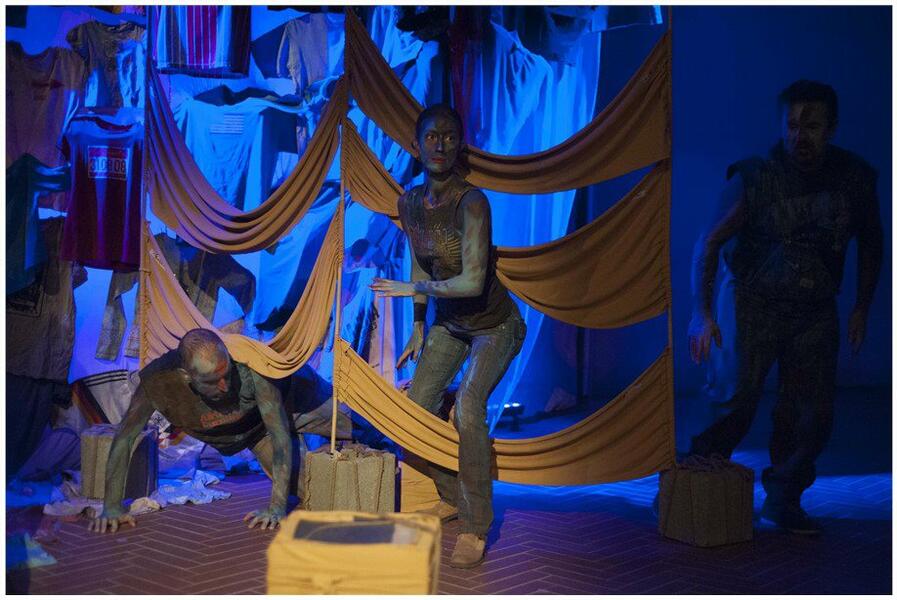 An Explorer's Desire"The Heart of an Explorer" by Bianca Bagatourian - allowed me to bring the actors onto the stage filled with fear, hope, curiosity and trepidation - many of the emotions we imagined would be truly felt by the 'newly arrived.'
An Explorer's Desire"The Heart of an Explorer" by Bianca Bagatourian - allowed me to bring the actors onto the stage filled with fear, hope, curiosity and trepidation - many of the emotions we imagined would be truly felt by the 'newly arrived.' -
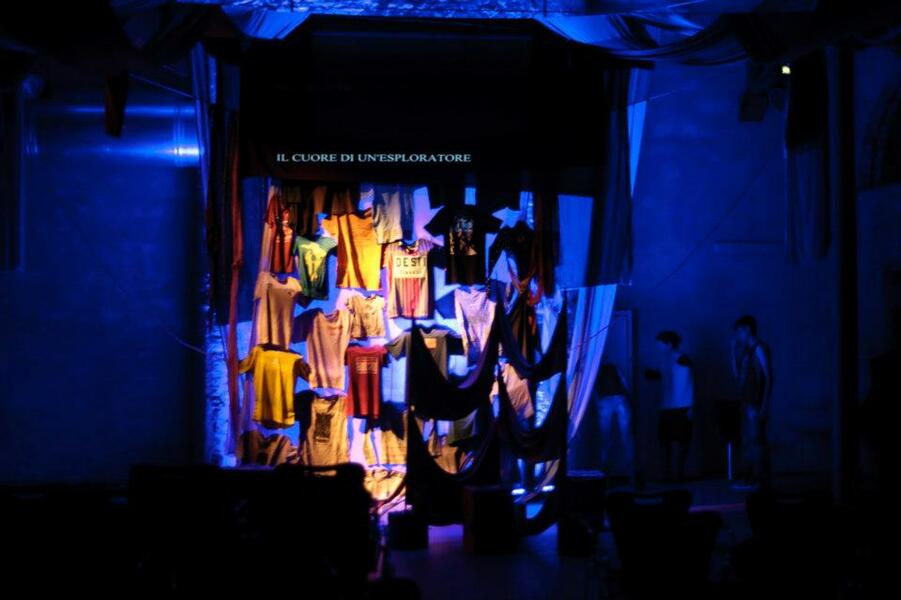 An Explorer's DesireIn both productions - Florence and Los Angeles - we used subtitles embedded in the set as well as relying on t-shirts as a visual theme. Designers Evan Bartoletti and Lisa Lechuga worked with me to consider which physical elements would truly represent a border crossing of cultures. For us the T-Shirt was the most obvious clothing item found in places as distant as the plains of Africa to New York City. We also wanted that sense of hope and uplift of flight by using them as a backdrop for the storytelling.
An Explorer's DesireIn both productions - Florence and Los Angeles - we used subtitles embedded in the set as well as relying on t-shirts as a visual theme. Designers Evan Bartoletti and Lisa Lechuga worked with me to consider which physical elements would truly represent a border crossing of cultures. For us the T-Shirt was the most obvious clothing item found in places as distant as the plains of Africa to New York City. We also wanted that sense of hope and uplift of flight by using them as a backdrop for the storytelling. -
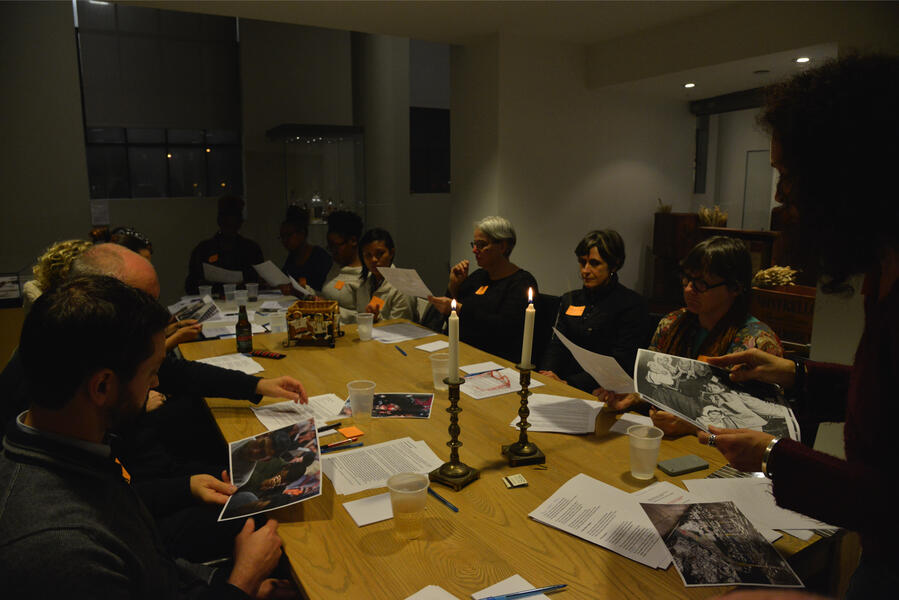 An Explorer's Desire: At TableWhen I came to Baltimore in 2015, I wanted to introduce myself and The Global Theatre Project to the city through this project. At this point I was interested in how to engage an audience differently on the subject of immigration. I began to experiment with using the Passover Seder as a way to utilize the material in a more intimate level with actors and audience going through a journey together. This was workshopped at CaseWerks.
An Explorer's Desire: At TableWhen I came to Baltimore in 2015, I wanted to introduce myself and The Global Theatre Project to the city through this project. At this point I was interested in how to engage an audience differently on the subject of immigration. I began to experiment with using the Passover Seder as a way to utilize the material in a more intimate level with actors and audience going through a journey together. This was workshopped at CaseWerks. -
At Table: An Explorer's DesireWhat became important from this new approach was both the use of ritual and of personal reflection which led to deep and open discussion between strangers.
-
Jewish Museum: An Explorer's DesireAfter trial and error we brought the performance to the Jewish Museum of Maryland with 40+ people at table as a part of the Light City Baltimore Festival. We were bringing 'light' to the issue of immigration and community.
-
Jewish Museum: An Explorer's DesireThe actors performed both at the table and in the open space between.
-
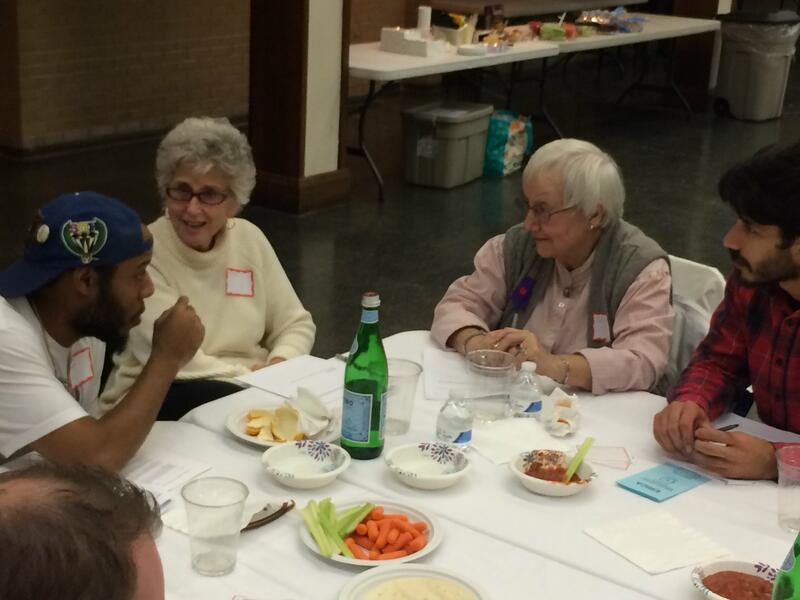 St. Marks: An Explorer's DesireWhen they were not performing they sat next to the audience members, they contemplated the same questions and went into deep discussion between each performed piece and at the end of the event. Togther they formed questions and spoke with a visiting expert as to how to approach the needs of immigrants/refugees in our city, our nation, our world.
St. Marks: An Explorer's DesireWhen they were not performing they sat next to the audience members, they contemplated the same questions and went into deep discussion between each performed piece and at the end of the event. Togther they formed questions and spoke with a visiting expert as to how to approach the needs of immigrants/refugees in our city, our nation, our world. -
Jewish Times Article.pdfConnecting Different Worlds Bari Hochwald uses theater to open hearts and minds.
The cover story for the February 28, 2018 edition of the Baltimore Jewish Times by Susan Ingram. In this article we discussed, among other things, my motivations for developing "An Explorer's Desire" and it's relationship to the larger vision for The Global Theatre Project.
Covid Projects
My commitment to the creative process and community renewal was forced onto an online platform. The pandemic gave opportunity to explore new media and technology. During this year of isolation and political/social turmoil I was interested in seeing how I could connect and inspire people within this structure. I sought this goal through these four projects.
-
The Four Pillars: KindnessThis video is a simple introduction to The Global Theatre Project's approach to theatre for social renewal. It was my first reaction as an artist to what I could and should offer once the pandemic set in and it was clear that a question of how we live together was something I wanted my work to continue to examine and inspire. The project, "The Four Pillars" was constructed as a series of discussions and deep explorations to lay a framework that brought individuals ranging from highly acclaimed artists to non-artist community members together as we explored each pillar in depth.
-
#The4Pillars: KindnessIs conversation and inquiry art? I believe it is. I believe, more and more as I develop my understanding of art's purpose in the development of healthy community, that our ability to converse is an art form to be approached as an artistic work. How do we navigate through another's preconceptions to arrive at a common question? How do we listen and inspire listening? How do we shape a moment between two human beings that can be lifted to an opportunity of insight that inspires and fires a spark in others. In much of my work conversation has become central. These online projects gave me the time and space to enter deeper into this improvised moment between human beings who are also conscious they are being watched by others. THAT is the audience element. Does it enhance what occurs, limit it or expand the possibility?
-
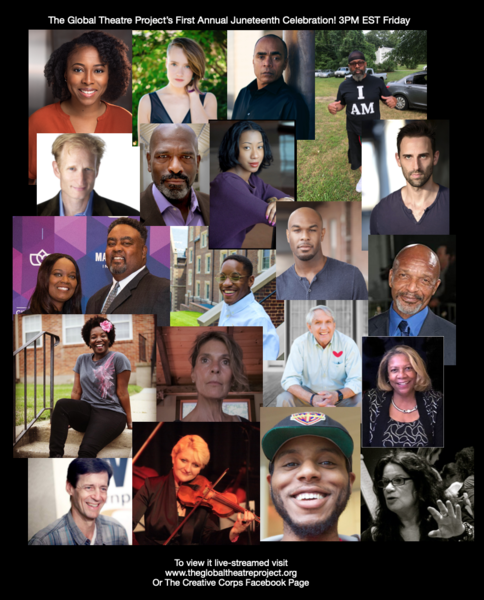 Invitation to JUNETEENTH CELEBRATIONStepping deeper into this format of consciously constructed discussion inspired by and through artistic expression, 2020 launched the Annual Juneteenth Celebration for The Global Theatre Project bring artists and non-artists together from Baltimore, New York, Los Angeles, Atlanta, and Shreveport, Louisiana.
Invitation to JUNETEENTH CELEBRATIONStepping deeper into this format of consciously constructed discussion inspired by and through artistic expression, 2020 launched the Annual Juneteenth Celebration for The Global Theatre Project bring artists and non-artists together from Baltimore, New York, Los Angeles, Atlanta, and Shreveport, Louisiana. -
The Global Theatre Project's 1st Annual Juneteenth CelebrationIn creating and hosting this event I was able to use my understanding of the power of art and deep discussion to both celebrate Black contributions to our nation and explore history that is not examined enough in our country. The multiple artists and community workers who contributed to this event demonstrated the expanse and importance of a community celebration of this kind. To examine exactly what my artistic expression is in this particular project I would look to the shaping of the day, the intention to connect individuals through their soul expression, through creating a space - albeit virtual - that inspired honest connection, deep searching and celebration.
-
Introduction to Our Voice Our DayThis short video is from the first two hour event of "Our Voice Our Day - why I love, hate or am confused about voting" "Our Voice Our Day" was developed with young artists in a 5-month-long creative engine that inspired civic engagement and community around voting. The events are grounded in the Four Pillar approach to theatre for social renewal as applied to a live streamed setting. Artists were trained in this approach prior to the event. Focusing on Kindness, Community, Artistry and Whole Artist Elements (Curiosity, Courage, Passion, Knowledge, Hunger, Connectivity, Sensual Development).
-
Five Hundred & Forty FiveThis was my contribution to the final event of "Our Voice Our Day" - 'Fill Your Ballot.' Having always been a performing artist, this was my first soujourn into a video format. I sought to clearly link my family legacy of immigration and the horrors inflicted under the Trump administration on people also seeking freedom and security a century later, to my vote.
-
Make Haste - Bari Hochwald and Marion FleetwoodThis collaboration with composer/musician Marion Fleetwood gave me the opportunity to perform my poetry utilizing a platform which I had not yet had the reason or the inclination to explore.
Community Engaged Work
As I've mentioned throughout, community engaged work has been a long-term theme for me. I am interested in how artists can consciously develop empathy through artistic engagement in society. This has been an evolving question for me. I have always been focused on multiple partnerships and collaborations - governmental, not-for-profits (non-arts), educational institutions and artists. Whenever possible, we have also sought multi-disciplinary participation while the focus of theatre, as the main approach for sharing the human narrative, lay at the center.
At this moment in my career I am focused on efforts toward the creation, production and teaching of a replicable approach which folds in the concept of the 7 elements of the Whole Artist: Curiosity (observation-research-inquiry) Passion (intimate alignment to subject matter) Sensual Development (five senses involvement) Connectivity (to others in group, those touched by subject matter, planet) Hunger (for remaining in the gray area of learning and questioning) Knowledge (socially expansive, politically questioning) Courage (facing truths learned and seeking a deeper view) These are elements of exploration I have identified necessary both for an artist to be truly open and ever-expanding and for all individuals to be able to touch into their creative selves from a place of awakening and experiential self-knowledge. At that point, an individual can participate in a creative collective in a way that leaves themselves and others enriched. The process toward community engaged art should intentionally contain and build upon these elements in order to participate in a necessary renewal of the way we live and interact together.
The following projects were some of those that formed the basis for the work of more recent years.
At this moment in my career I am focused on efforts toward the creation, production and teaching of a replicable approach which folds in the concept of the 7 elements of the Whole Artist: Curiosity (observation-research-inquiry) Passion (intimate alignment to subject matter) Sensual Development (five senses involvement) Connectivity (to others in group, those touched by subject matter, planet) Hunger (for remaining in the gray area of learning and questioning) Knowledge (socially expansive, politically questioning) Courage (facing truths learned and seeking a deeper view) These are elements of exploration I have identified necessary both for an artist to be truly open and ever-expanding and for all individuals to be able to touch into their creative selves from a place of awakening and experiential self-knowledge. At that point, an individual can participate in a creative collective in a way that leaves themselves and others enriched. The process toward community engaged art should intentionally contain and build upon these elements in order to participate in a necessary renewal of the way we live and interact together.
The following projects were some of those that formed the basis for the work of more recent years.
-
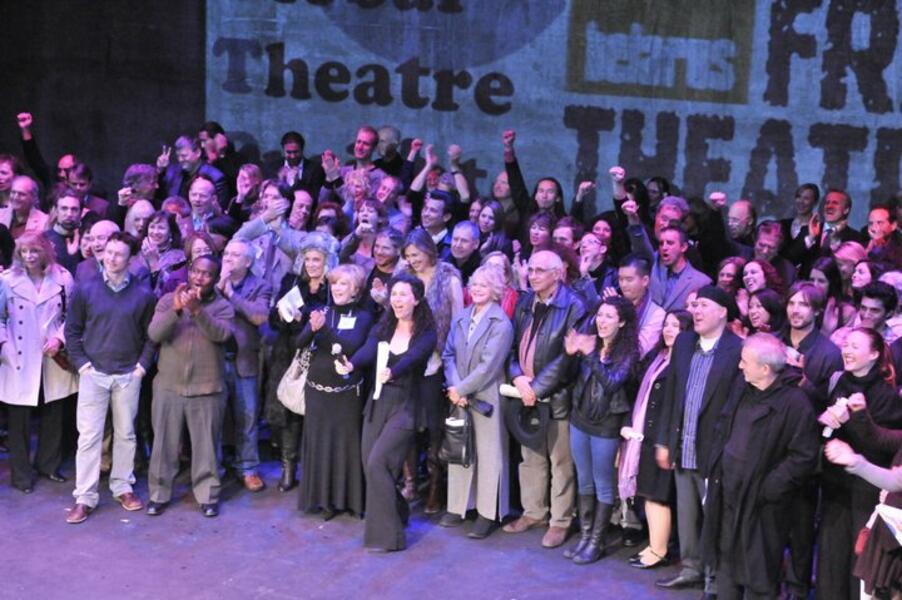 The Global Theatre Project: Inauguration EventThe Global Theatre Project inaugurated by joining an international call to bring awareness to the danger Belarus Free Theatre was under in a dictator-controlled, torturous government. We created an event culminating in the filming of a message of support asking the whole audience to come on stage. The message was used by Belarus Free Theatre to gain attention by sympathetic nations.
The Global Theatre Project: Inauguration EventThe Global Theatre Project inaugurated by joining an international call to bring awareness to the danger Belarus Free Theatre was under in a dictator-controlled, torturous government. We created an event culminating in the filming of a message of support asking the whole audience to come on stage. The message was used by Belarus Free Theatre to gain attention by sympathetic nations. -
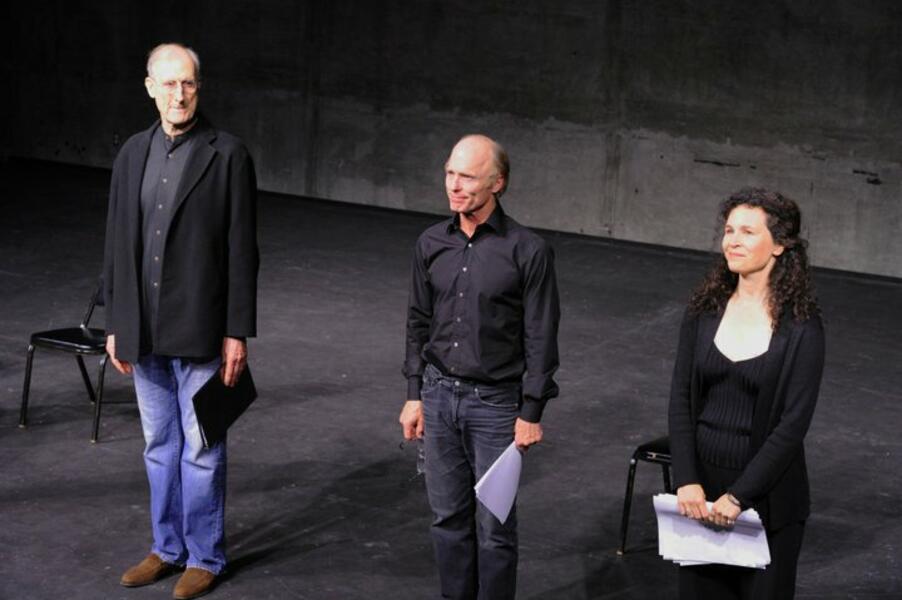 The Global Theatre Project: Inauguration EventI directed and performed with James Cromwell and Ed Harris along with other powerful performers in a piece written by Nicolai Khalezin - Being Harold Pinter - at the Los Angeles Theatre Center. An Amnesty International Representative was there to discuss the situation in Belarus with our audience and what we each could do to assist.
The Global Theatre Project: Inauguration EventI directed and performed with James Cromwell and Ed Harris along with other powerful performers in a piece written by Nicolai Khalezin - Being Harold Pinter - at the Los Angeles Theatre Center. An Amnesty International Representative was there to discuss the situation in Belarus with our audience and what we each could do to assist. -
Double Double Sonnet ProjectThe second annual 'Stratford Shakespeare Connection' project, initiated in Florence, Italy. This community event brought artists and residents together from throughout Los Angeles to utilize the language of Shakespeare in a message of love. The day-long project was prepared for in advance by artists who worked in groups with whoever appeared for participation, held a rehearsal and then was filmed and screened in Stratford, England as a part of their annual Shakespeare Birthday Festival. Multiple languages, including American Sign Language was employed.
-
The 'Double Double' Sonnet ProjectThe film which screened at the Stratford England Shakespeare Birthday Festival.
-
Rapping On The TempestThird of the Stratford Shakespeare Connection. Rapping on the Tempest was a collaboration with Heart of Los Angeles Youth and UCLA Drama Department. The artists met for several weeks prior to prepare, each was responsible for various aspects of this moving theatre event/filming. We began in a local park, crossed the streets of Wilshire Blvd and ended up in a gallery. Our artists met with the youth prior and community members were also invited to participated. This was the first time anyone had asked the children of this community what they thought about our international relations and what their concerns were for our world. The project focus was on waking up.
-
Rapping on the TempestThe film of Rapping on the Tempest which screened at the Shakespeare Birthday Festival, Stratford.
-
What is Our Part?Artists of The Global Theatre Project worked with Actors for Autism to bring the Stratford Shakespeare Connection event to their community. Because of the nature of their challenges, this event was not open to the community at large, but designed specifically for this group. The film was, again, screened at Stratford England as a part of their Shakespeare Birthday Festival. The connection between Stratford and this group of young people was deeply impacting for both sides of 'the pond.'
-
 Creative CorpsCreative Corps is an initiative I began in Florence, Italy in response to the dysfunctional relationship between the residents of the city and the visiting US college students. There was a disconnect and it seemed apparent that a conciously structured arts-engagement between the communities would bring a positive aspect to the situation. Over 10 years, and beginning as "Creative Campus Global Initiative" we worked with well over 1,000 students on over 60 projects engaging them with thousands of community members in projects large and small. This is a multi-disciplined event created by them called "Stereotypes."
Creative CorpsCreative Corps is an initiative I began in Florence, Italy in response to the dysfunctional relationship between the residents of the city and the visiting US college students. There was a disconnect and it seemed apparent that a conciously structured arts-engagement between the communities would bring a positive aspect to the situation. Over 10 years, and beginning as "Creative Campus Global Initiative" we worked with well over 1,000 students on over 60 projects engaging them with thousands of community members in projects large and small. This is a multi-disciplined event created by them called "Stereotypes." -
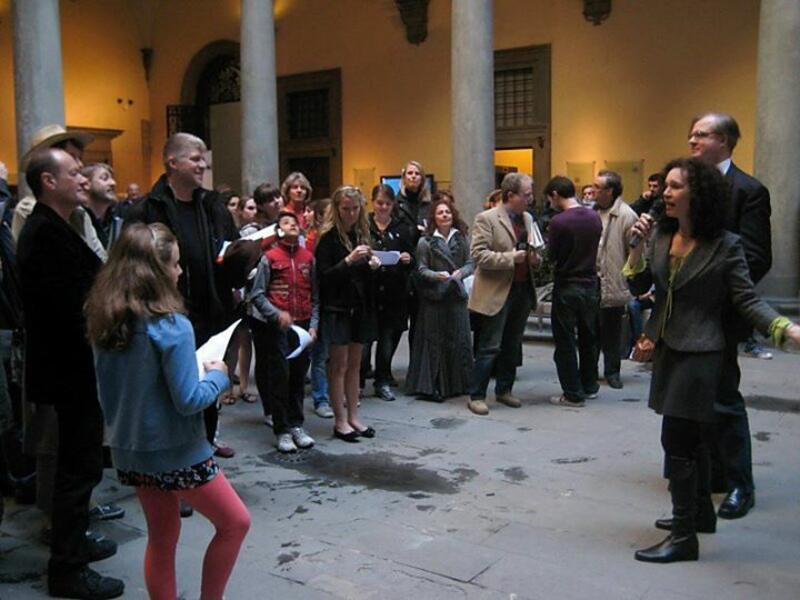 An International Romeo and JulietOrchestrating the first of the Stratford Shakespeare Connection projects which took place in Palazzo Strozzi, Florence, Italy. In association with the Strozzi Museum this event was open to all members of the community. With the assistance of local artists, the space was utilized to invite multiple Juliets and Romeos in multiple languages. Along with community members of all ages and university students, visiting tourists also took part.
An International Romeo and JulietOrchestrating the first of the Stratford Shakespeare Connection projects which took place in Palazzo Strozzi, Florence, Italy. In association with the Strozzi Museum this event was open to all members of the community. With the assistance of local artists, the space was utilized to invite multiple Juliets and Romeos in multiple languages. Along with community members of all ages and university students, visiting tourists also took part. -
An international Romeo and Juliet in FlorenceThis video was made during the community event and screened at Stratford, England at the Shakespeare Birthday Festival as the first of four contributions to our partnership with the Birthday Commission of the City of Stratford.
A Stubborn Woman: Anna Politkovskaya
In Florence I met the playwright Stefano Massini who wrote A Stubborn Woman. The piece was written in chapters compiled from the writing of Anna Politkovskaya. Ms. Politkovskaya was the Russian journalist believed murdered by her own country for reporting honestly about the Chechen-Russian conflict.
Stefano's play was written in Italian and not broken into roles. I was interested in doing a bi-lingual version and having three actors represent Ms. Politkovskaya's voice with a Greek style chorus of young voices who would energetically push the moments of each piece to an emotional center and represent the generation influenced by suppressed journalistic voices.
Since Ms. Politkovskaya was a journalist whose medium was the newspaper, we devised multiple uses for newspaper until, at the end of the performance, the show was littered with crumpled, stamped on material which held so much import for Ms. Politkovskaya that she died for it. I am also interested in the use of objects in unexpected ways, and the chairs which were on stage were utilized as cages or entrapment and to give a sense of imbalance. Water was an important theme in the writing - so this element was also incorporated from the beginning in various ways.
Both productions - in Florence as a part of the Firenze Estate (Florence Summer) festival and the one at the Los Angeles Theatre Center - were performed bilingually with corresponding subtitles. The question we asked at both performances was why, in our democratic countries, should we be concerned with the issue of violence against journalists. Sadly that inquiry has become all to vital a question in recent years.
Stefano's play was written in Italian and not broken into roles. I was interested in doing a bi-lingual version and having three actors represent Ms. Politkovskaya's voice with a Greek style chorus of young voices who would energetically push the moments of each piece to an emotional center and represent the generation influenced by suppressed journalistic voices.
Since Ms. Politkovskaya was a journalist whose medium was the newspaper, we devised multiple uses for newspaper until, at the end of the performance, the show was littered with crumpled, stamped on material which held so much import for Ms. Politkovskaya that she died for it. I am also interested in the use of objects in unexpected ways, and the chairs which were on stage were utilized as cages or entrapment and to give a sense of imbalance. Water was an important theme in the writing - so this element was also incorporated from the beginning in various ways.
Both productions - in Florence as a part of the Firenze Estate (Florence Summer) festival and the one at the Los Angeles Theatre Center - were performed bilingually with corresponding subtitles. The question we asked at both performances was why, in our democratic countries, should we be concerned with the issue of violence against journalists. Sadly that inquiry has become all to vital a question in recent years.
-
A Stubborn WomanSegments from the presentation of Stefano Massini's play. The three actors representing her voice performed their parts from notebooks that were representative of a reporter's notepad.
-
 A Stubborn WomanI was interested in when we might use the newspapers and bodies of the chorus as a frame of the words of the play, and when that frame could have multiple implications.
A Stubborn WomanI was interested in when we might use the newspapers and bodies of the chorus as a frame of the words of the play, and when that frame could have multiple implications. -
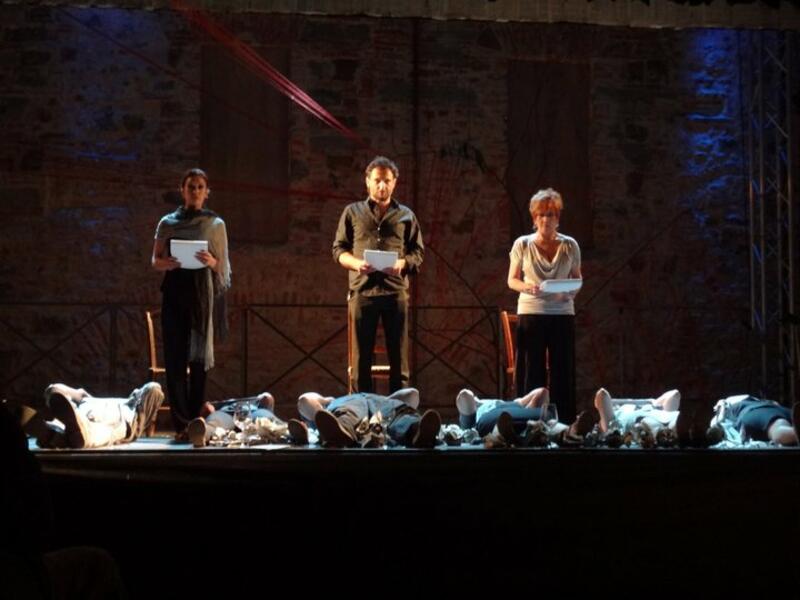 A Stubborn Woman: Anna PolitkovskayaEach chapter of the play covered a different event or concern in the life of Ms. Politkovskaya. This particular piece seemed to me to ask "who is the enemy" as she stood over the graves of Chechen children. And it left me with this question infused in my work for several years after. This need to demonize and 'otherize' drives much of my creative inquiry and community work.
A Stubborn Woman: Anna PolitkovskayaEach chapter of the play covered a different event or concern in the life of Ms. Politkovskaya. This particular piece seemed to me to ask "who is the enemy" as she stood over the graves of Chechen children. And it left me with this question infused in my work for several years after. This need to demonize and 'otherize' drives much of my creative inquiry and community work. -
 A Stubborn WomanI am moved by the interaction between presentational and realistic approaches to theatre. Sometimes communicating that to an actor can be a challenge - how to hold onto their emotional life while also holding a strong physical shape can seem a contradiction to American-trained actors who seek inner truth as a guidestar. Italian actors have had less problem with the presentation and more challenges with the emotional interior. It's been a great training ground for me to work in both cultures. And, when possible, to bring them together on the same stage.
A Stubborn WomanI am moved by the interaction between presentational and realistic approaches to theatre. Sometimes communicating that to an actor can be a challenge - how to hold onto their emotional life while also holding a strong physical shape can seem a contradiction to American-trained actors who seek inner truth as a guidestar. Italian actors have had less problem with the presentation and more challenges with the emotional interior. It's been a great training ground for me to work in both cultures. And, when possible, to bring them together on the same stage. -
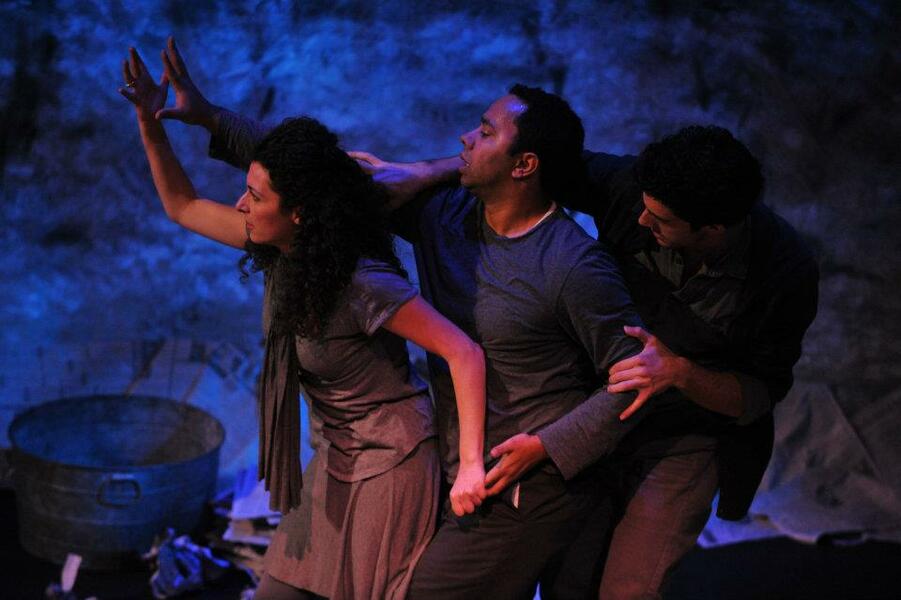 A Stubborn WomanMy approach to work is a combination of devising and then structuring into what I hope is powerful storytelling. I explore with the actors - pushing them to the extent of their imagination and physical expression, and then contain this work into a form. I think of my direction oftentimes as painting visual pictures with bodies in motion and in stillness.
A Stubborn WomanMy approach to work is a combination of devising and then structuring into what I hope is powerful storytelling. I explore with the actors - pushing them to the extent of their imagination and physical expression, and then contain this work into a form. I think of my direction oftentimes as painting visual pictures with bodies in motion and in stillness. -
 A Stubborn WomanI am drawn to rythm and sound. Particularly sound generated by the actors themselves. The newspaper crumbled as to accompany a piece about a city on fire, or ripped slowly to emphasize the coming of winter. Water quietly lifted and released in a tin basin with all attention given to the source of the sound to suspend a moment where all things are falling apart.
A Stubborn WomanI am drawn to rythm and sound. Particularly sound generated by the actors themselves. The newspaper crumbled as to accompany a piece about a city on fire, or ripped slowly to emphasize the coming of winter. Water quietly lifted and released in a tin basin with all attention given to the source of the sound to suspend a moment where all things are falling apart. -
 A Stubborn WomanUsing young actors in this piece allowed me to play with their youth in contradiction to the harshness of the violence depicted in the text. Moments, such as this, allowed me to use a children's game of Ring-Around-The-Rosey while reciting international conflict issues, and then quickly and harshly move into a salute covering their mouths and stamping their feet as a staccatto emphasis on censorship of the reporting by Ms. Politkovskaya on those conflicts.
A Stubborn WomanUsing young actors in this piece allowed me to play with their youth in contradiction to the harshness of the violence depicted in the text. Moments, such as this, allowed me to use a children's game of Ring-Around-The-Rosey while reciting international conflict issues, and then quickly and harshly move into a salute covering their mouths and stamping their feet as a staccatto emphasis on censorship of the reporting by Ms. Politkovskaya on those conflicts. -
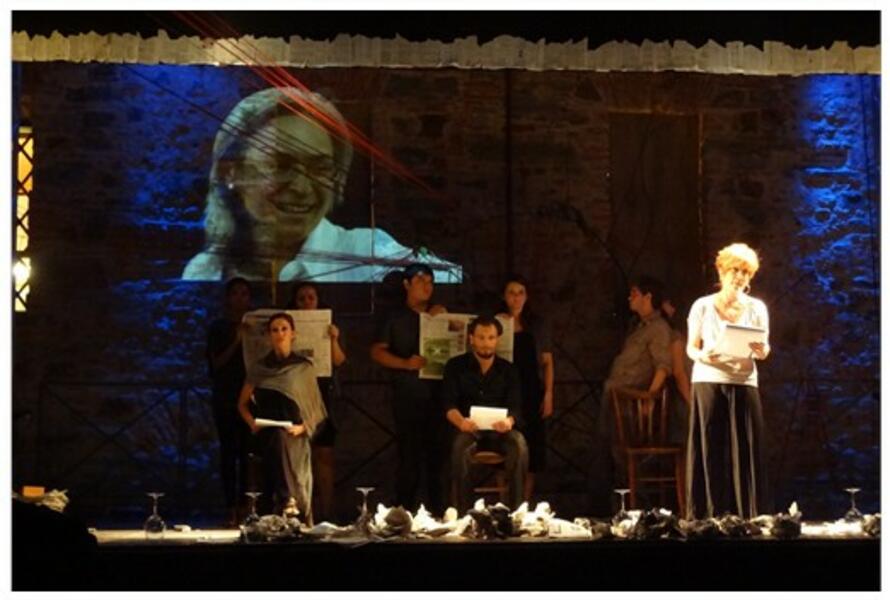 A Stubborn WomanThe final moment of the play we decided to bring in an image of Anna Politkovskaya. I wanted to give the audience the opportunity to see the woman whose words they have been listening to and whose passion and commitment they have learned about. After her image came up as the event moved to a conclusion we also added the faces of - at that time - many of the 300 journalists who had been murdered as a result of doing their work in countries throughout the world.
A Stubborn WomanThe final moment of the play we decided to bring in an image of Anna Politkovskaya. I wanted to give the audience the opportunity to see the woman whose words they have been listening to and whose passion and commitment they have learned about. After her image came up as the event moved to a conclusion we also added the faces of - at that time - many of the 300 journalists who had been murdered as a result of doing their work in countries throughout the world. -
Chorus members of A Stubborn WomanI am sharing this short video because part of what I truly believe is my artistry is in awakening artists and community members to pay more attention to the world around them. I seek to do this in the process I bring my artists through and the event we create to share with the public itself. And both of those things - the process and the final product - are what I look at with an eye toward shaping and honing as I grow as an individual and creative being.
The Medici Dynasty Show
This production was created in Florence, Italy to celebrate the legacy of the last remaining Medici family members and gifts they left future generations of art, architecture, literature and design. The show was performed on the alter of Il Fuligno, a baroque church built in 1601. I curated the script toward a performance-worthy text and directed the show. I was interested in enveloping the audience in both the magnificence of the city's treasures as well as the personal and collective struggles of the brother and sister - Anna Maria Luisa and Gian Gastone - as they navigated an imagined last moment together. The challenge of the piece was to create an entertaining and strong human journey while sharing historic information. And to create a definitive, powerful female character. The production ran, in English, for three years with Italian touring versions throughout that time period.
-
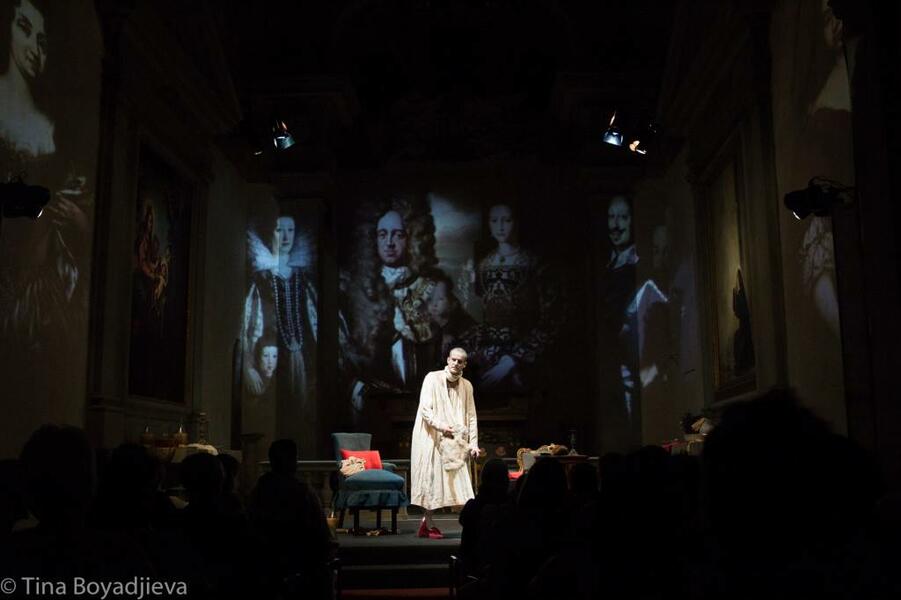 The Medici Dynasty ShowTim Daish performed the role of Gian Gastone de’ Medici
The Medici Dynasty ShowTim Daish performed the role of Gian Gastone de’ Medici -
 The Medici Dynasty ShowTim with Carolina Gamini as his sister Anna Maria Luisa de’ Medici. I wanted to begin the piece as simply and stark as possible, utilizing the space itself (which had its own beauty) and not engaging yet too much with the projections.
The Medici Dynasty ShowTim with Carolina Gamini as his sister Anna Maria Luisa de’ Medici. I wanted to begin the piece as simply and stark as possible, utilizing the space itself (which had its own beauty) and not engaging yet too much with the projections. -
 The Medici Dynasty ShowThe legacy of Gian Gastone was one of debauchery and excess. In order to emphasize this I worked with Tim to expand his performance to incorporate comedia dell'arte-inspired moments contrasted with moments of emotional reflection.
The Medici Dynasty ShowThe legacy of Gian Gastone was one of debauchery and excess. In order to emphasize this I worked with Tim to expand his performance to incorporate comedia dell'arte-inspired moments contrasted with moments of emotional reflection. -
 The Medici Dynasty ShowBecause neither sibling had children, Anna Marie Luisa was determined to save the legacy of the Medici family from the inevitable - Florence being sacked and sold piece by piece by whoever was next to govern. To help the audience feel that loss, the projections chosen were oftentimes rich in style and color and were an expansion of the emotional and textual expression of the characters.
The Medici Dynasty ShowBecause neither sibling had children, Anna Marie Luisa was determined to save the legacy of the Medici family from the inevitable - Florence being sacked and sold piece by piece by whoever was next to govern. To help the audience feel that loss, the projections chosen were oftentimes rich in style and color and were an expansion of the emotional and textual expression of the characters. -
 The Medici Dynasty ShowIn creating a love affair with their family history and contributions to art, music, architecture, we used video mapping to transform the church into a visual celebration of the artists and architects the Medicis supported over their 300 year reign. The music and sound was also reflective of this desire to create a lush, memory-infused world for the audience.
The Medici Dynasty ShowIn creating a love affair with their family history and contributions to art, music, architecture, we used video mapping to transform the church into a visual celebration of the artists and architects the Medicis supported over their 300 year reign. The music and sound was also reflective of this desire to create a lush, memory-infused world for the audience. -
 The Medici Dynasty ShowThe performance style of the actors was both highly presentational, and deeply intimate. The dynamics we created between the siblings allowed us to find humor and pathos which helped the audience connect to their humanity.
The Medici Dynasty ShowThe performance style of the actors was both highly presentational, and deeply intimate. The dynamics we created between the siblings allowed us to find humor and pathos which helped the audience connect to their humanity. -
 The Medici Dynasty ShowWe recognized in creating the piece in this lesser-known but important location that we could develop a transportational experience for the audience as the storytelling and the emotional direction of the characters moved forward. The starkness of the space was perfect for 'painting' with the projections whichever location, emotion, or image helped to support each moment. And allowed for a coldness to emphasize breaks in their relationship when we chose to project nothing.
The Medici Dynasty ShowWe recognized in creating the piece in this lesser-known but important location that we could develop a transportational experience for the audience as the storytelling and the emotional direction of the characters moved forward. The starkness of the space was perfect for 'painting' with the projections whichever location, emotion, or image helped to support each moment. And allowed for a coldness to emphasize breaks in their relationship when we chose to project nothing. -
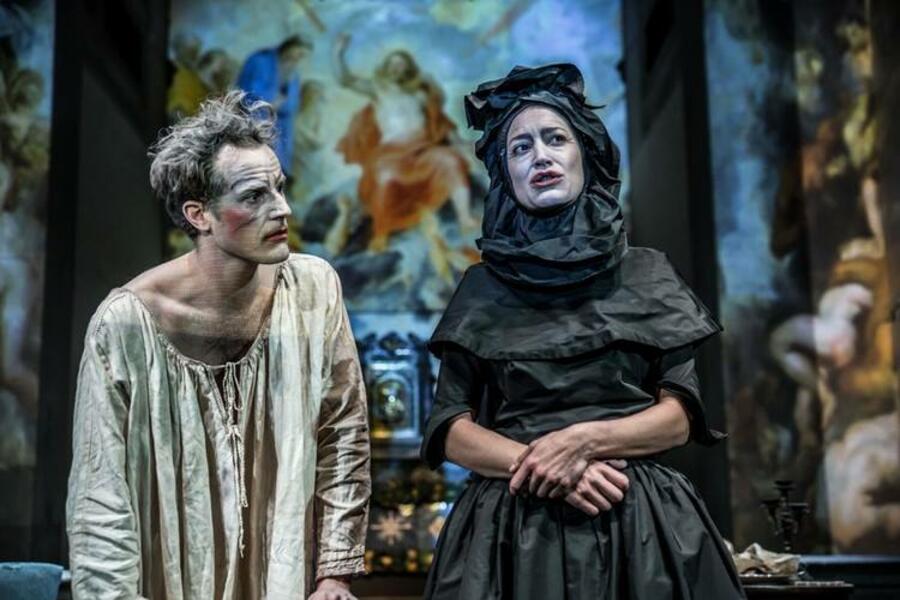 The Medici Dynasty ShowBecause the idea of "the family pact" - which secured that no artwork, literature, architure, etc. could be taken out of the city - came from Anna Marie Luisa, we were able to use her passion to direct her brother toward a redemptive end. We chose to leave the audience with a sense of celebration and, in order to do that, needed to find a common ground for the two of them - their love of Florence.
The Medici Dynasty ShowBecause the idea of "the family pact" - which secured that no artwork, literature, architure, etc. could be taken out of the city - came from Anna Marie Luisa, we were able to use her passion to direct her brother toward a redemptive end. We chose to leave the audience with a sense of celebration and, in order to do that, needed to find a common ground for the two of them - their love of Florence. -
 The Medici Dynasty ShowThe opportunity to celebrate the power of a woman's vision was important to me in this production. It was vital that Carolina's performance was clear, and the text she was given emotionally supportive of both the theatrical experience and the sharing of a moment in history unknown to most people. A moment which, in one way or another, has touched countless lives in the modern world.
The Medici Dynasty ShowThe opportunity to celebrate the power of a woman's vision was important to me in this production. It was vital that Carolina's performance was clear, and the text she was given emotionally supportive of both the theatrical experience and the sharing of a moment in history unknown to most people. A moment which, in one way or another, has touched countless lives in the modern world. -
The Medici Dynasty ShowThis is a brief trailer for the production.
Belarus Dream Theatre
When I founded The Global Theatre Project (The GTP) our inaugural event was to bring attention and activism to the plight of Belarus Free Theatre in their country. This put me in relationship with a few individuals working in that area one being Brendan McCall who initated a global event the following year - Belarus Dream Theatre. 18 theatres participated and The GTP did as well. Representing two of those 18 theatres, I simultaneously produced the events in Los Angeles and Florence (directing the one in Florence).
At this point I had put together a committed group of artists in both cities who were motivated by the idea of working with youth and community members to bring activism to important social issues as well as stretching their own artistry. Belarus was a European dictatorship masked as a democracy where 1,000 people a year disappeared. The question of censorship was one I wanted those of us who lived in the US and Italy to contemplate.
I brought together 80 artists and youth associates, identified various partners in both cities. In Los Angeles our artists worked with two high schools, educating them on Belarus, exploring questions of censorship and creating both their own pieces and assisting the designers on the set design. On the night of the event, the students performed in the theatre lobby and the professional artists performed on the set created by them.
In Florence, we worked with Italian and US university students creating a week-long event bringing attention to this issue in partnership with Amnesty International and the Mayor's office of Florence culminating in the final performance at Le Murate.
This piece gave me the opportunity to deepen my inquiry as a director into the relationship with the audience and the artist which was a question I had begun exploring as well as to continue to find my personal artistry in community-engaged social issue programming.
At this point I had put together a committed group of artists in both cities who were motivated by the idea of working with youth and community members to bring activism to important social issues as well as stretching their own artistry. Belarus was a European dictatorship masked as a democracy where 1,000 people a year disappeared. The question of censorship was one I wanted those of us who lived in the US and Italy to contemplate.
I brought together 80 artists and youth associates, identified various partners in both cities. In Los Angeles our artists worked with two high schools, educating them on Belarus, exploring questions of censorship and creating both their own pieces and assisting the designers on the set design. On the night of the event, the students performed in the theatre lobby and the professional artists performed on the set created by them.
In Florence, we worked with Italian and US university students creating a week-long event bringing attention to this issue in partnership with Amnesty International and the Mayor's office of Florence culminating in the final performance at Le Murate.
This piece gave me the opportunity to deepen my inquiry as a director into the relationship with the audience and the artist which was a question I had begun exploring as well as to continue to find my personal artistry in community-engaged social issue programming.
-
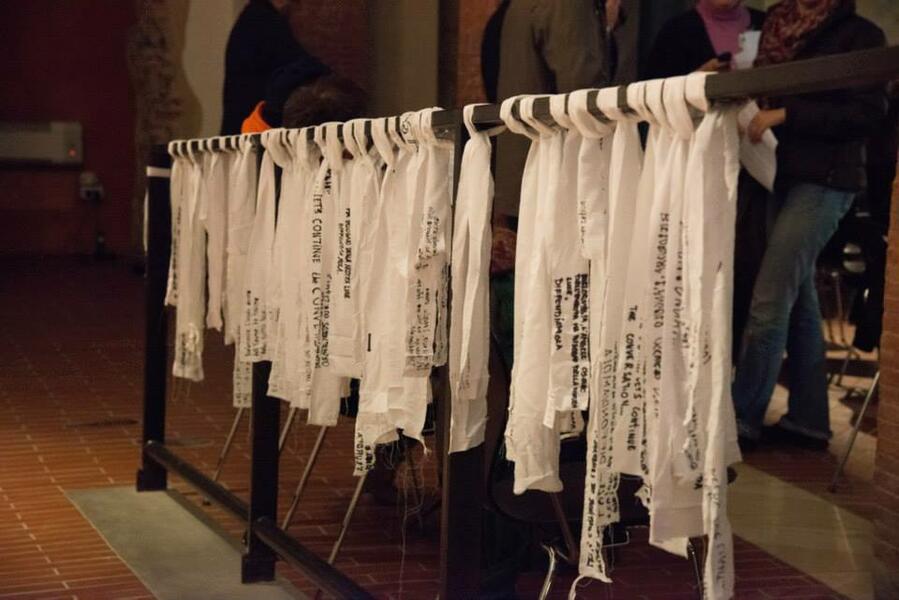 Florence: Belarus Dream TheatreWorking with artists and youth of multiple disciplines I tasked the visual art students to create an environment for the audience the moment they entered. We decided the gag was an important image and we offered the audience the possibility to wear one throughout the performance.
Florence: Belarus Dream TheatreWorking with artists and youth of multiple disciplines I tasked the visual art students to create an environment for the audience the moment they entered. We decided the gag was an important image and we offered the audience the possibility to wear one throughout the performance. -
 Florence: Belarus Dream TheatreIn order also to give the sense of control of movement and space, and to acknowledge the members of Belarus Free Theatre who were under threat of torture from the Belarussian government, the students created webbed 'no pass' areas to force the audience to move in only one direction with string and images of the company members.
Florence: Belarus Dream TheatreIn order also to give the sense of control of movement and space, and to acknowledge the members of Belarus Free Theatre who were under threat of torture from the Belarussian government, the students created webbed 'no pass' areas to force the audience to move in only one direction with string and images of the company members. -
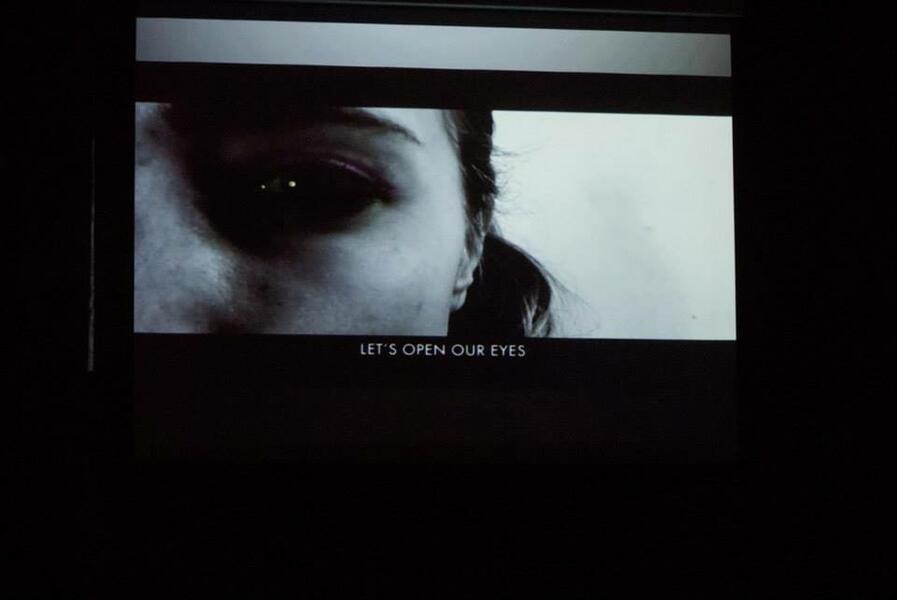 Florence: Belarus Dream TheatreWhen I work on community projects one thing which is vital is that everyone brings their passion and talent and I shape that into the event. In this case we had a filmmaker who wanted to make a statement about activism and Belarus. I used this as an opener to the event.
Florence: Belarus Dream TheatreWhen I work on community projects one thing which is vital is that everyone brings their passion and talent and I shape that into the event. In this case we had a filmmaker who wanted to make a statement about activism and Belarus. I used this as an opener to the event. -
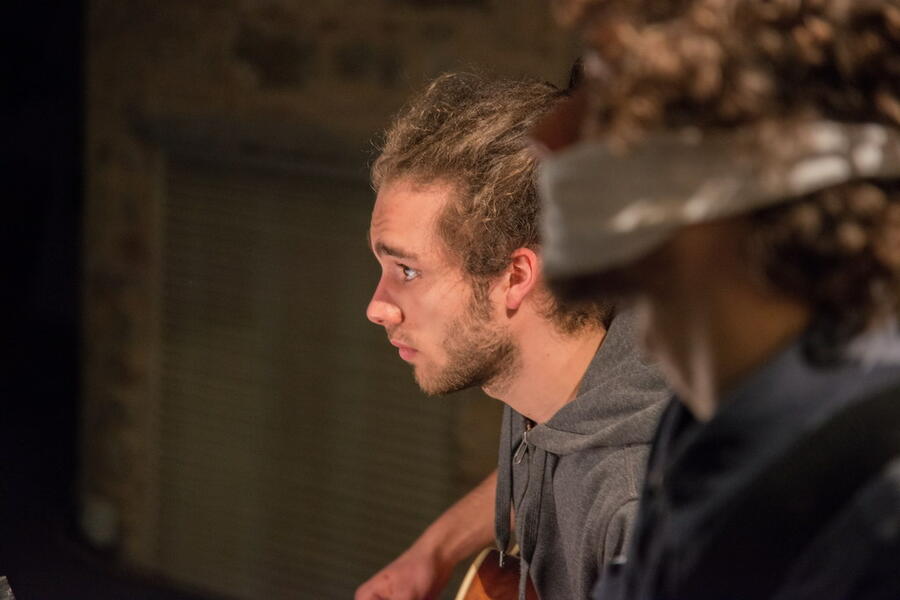 Florence: Belarus Dream TheatreOriginal music was created by Andrea Cagnola who performed with another student, both on guitar. The music bridged each short piece as well as the entry and exit of the audience. I was interested in using the gagging in ways that carried the theme, from our poster until the end of the piece and so put one of the musicians into a gag throughout the event. I wanted a sense of randomness - we can't ever know who will be silenced or why in a dictatorship. Nor can we ask.
Florence: Belarus Dream TheatreOriginal music was created by Andrea Cagnola who performed with another student, both on guitar. The music bridged each short piece as well as the entry and exit of the audience. I was interested in using the gagging in ways that carried the theme, from our poster until the end of the piece and so put one of the musicians into a gag throughout the event. I wanted a sense of randomness - we can't ever know who will be silenced or why in a dictatorship. Nor can we ask. -
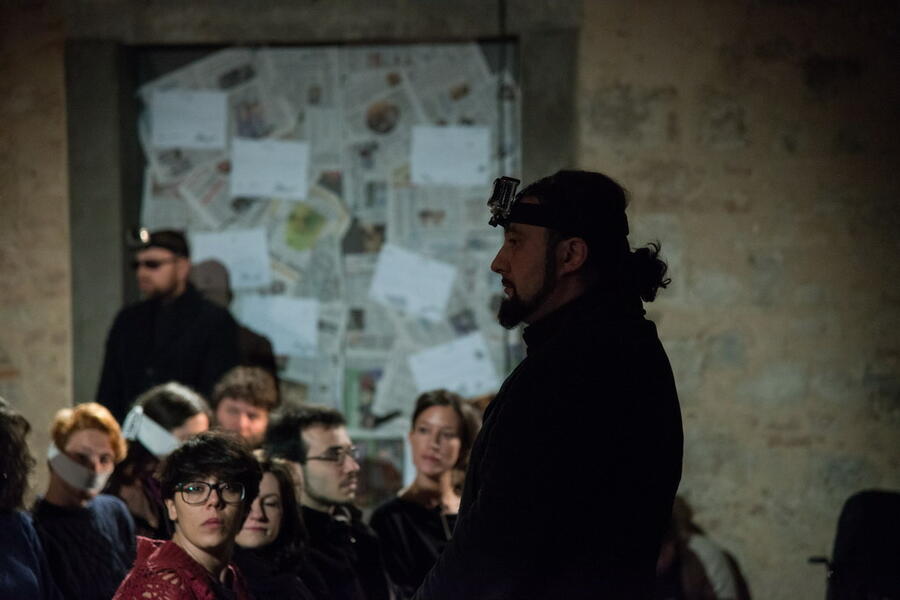 Florence: Belarus Dream TheatreThe visual art students wanted to educate the audience, at the same time I wanted a sense of feeling claustrophobic. All windows and doors were covered with newsclippings and facts about Belarus. Throughout the performance two men in black with recording devices on their heads moved throughout the audience randomly.
Florence: Belarus Dream TheatreThe visual art students wanted to educate the audience, at the same time I wanted a sense of feeling claustrophobic. All windows and doors were covered with newsclippings and facts about Belarus. Throughout the performance two men in black with recording devices on their heads moved throughout the audience randomly. -
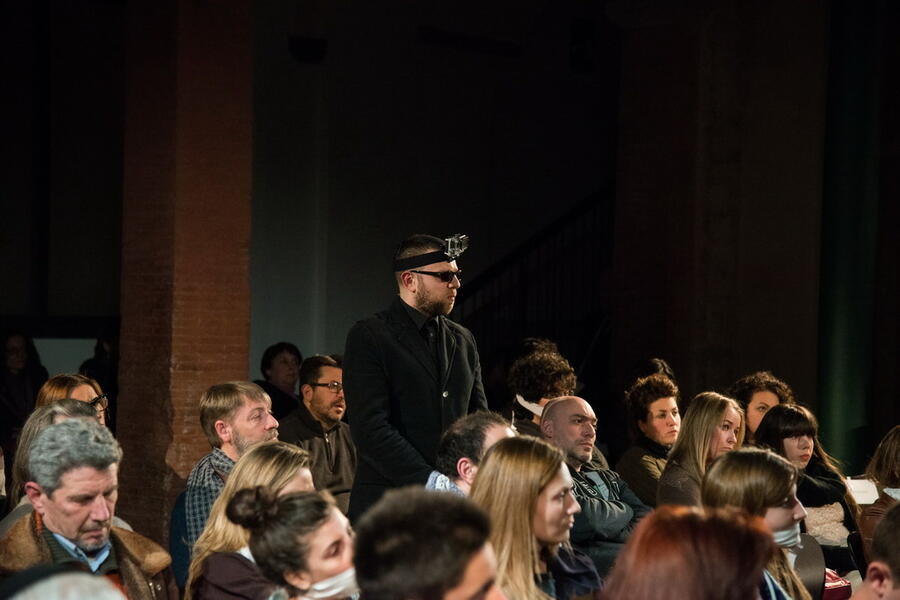 Florence: Belarus Dream TheatreThe idea of theatre being still, silent and uninterrupted was something I wanted to break in this piece. I was interested in what the audience would do as Marco and Marcello did not hold to that concept and took whatever space they felt they wanted.
Florence: Belarus Dream TheatreThe idea of theatre being still, silent and uninterrupted was something I wanted to break in this piece. I was interested in what the audience would do as Marco and Marcello did not hold to that concept and took whatever space they felt they wanted. -
 Florence: Belarus Dream TheatreStudents and their professor who I worked with stayed gagged throughout the performance sitting as audience members until the very end. This element was not only a design, but an opportunity for those who participated to feel engaged in an event creatively. They had studied with me and understood the issues, read the text and became a part of the community of this project. This was their creative contribution.
Florence: Belarus Dream TheatreStudents and their professor who I worked with stayed gagged throughout the performance sitting as audience members until the very end. This element was not only a design, but an opportunity for those who participated to feel engaged in an event creatively. They had studied with me and understood the issues, read the text and became a part of the community of this project. This was their creative contribution. -
 Florence: Belarus Dream TheatreI wanted to see what would happen if as many norms were broken as possible. As happens in an authoritarian world. So I began the evening standing on the stage, introducing the event. Then the lights came down on me and up on the audience. And that is where it stayed. The actors were among them, rising out of their seats as called for. It was fascinating to watch the audience's need to look ahead, even when the actor (Rosario far left standing) was right near them. A question of intimacy was started there for me - how can an audience truly become a participant and not a passive observer?
Florence: Belarus Dream TheatreI wanted to see what would happen if as many norms were broken as possible. As happens in an authoritarian world. So I began the evening standing on the stage, introducing the event. Then the lights came down on me and up on the audience. And that is where it stayed. The actors were among them, rising out of their seats as called for. It was fascinating to watch the audience's need to look ahead, even when the actor (Rosario far left standing) was right near them. A question of intimacy was started there for me - how can an audience truly become a participant and not a passive observer? -
 Florence: Belarus Dream TheatreSimcha Jelenik escaped communist Czechoslovakia when he was a young man. Near the end of the event I had him rise and begin to sing a song in Russian that had particular meaning to him. During this we projected images of individuals who have 'been disappeared' in Belarus. The gagged students stood slowly to honor these individuals.
Florence: Belarus Dream TheatreSimcha Jelenik escaped communist Czechoslovakia when he was a young man. Near the end of the event I had him rise and begin to sing a song in Russian that had particular meaning to him. During this we projected images of individuals who have 'been disappeared' in Belarus. The gagged students stood slowly to honor these individuals. -
 Belarus Dream TheatreThe final moment of the evening was one of Simcha's voice. Then silence. We had requested no applause, as applause was banned in Belarus. The audience was then invited to speak to Amnesty International and sign petitions to assist those still believed to be imprisoned for speaking their minds. We also held a discussion on censorship in democracy and which pieces performed that evening evoked emotion or thought in audience members and participants.
Belarus Dream TheatreThe final moment of the evening was one of Simcha's voice. Then silence. We had requested no applause, as applause was banned in Belarus. The audience was then invited to speak to Amnesty International and sign petitions to assist those still believed to be imprisoned for speaking their minds. We also held a discussion on censorship in democracy and which pieces performed that evening evoked emotion or thought in audience members and participants.
Stop The Violence
Having participated in Eve Ensler's "The Vagina Monologue" events for several years, I wanted The Global Theatre Project to be a part of One Billion Rising. What I envisioned for this project deepened my community-engaged work and the multiple levels of participation and creativity I enjoy layering into such events.
This project saw over 3,000 people come to Piazza Repubblica in Florence, Italy to participate in the global effort to bring attention and an end to violence against women and girls. I brought a choreographer from the US to Florence, and in line with the approach to our community work (engaging artists with youth and community members), had her teach the movement to visiting US students as her assistant teachers.
Communities who were trained in the flashmob dance worked for two weeks at in-person sessions and watched the online training video over 15,000 times to prepare for the event. I included street puppetry as well as spoken word and partnered with Artemisia Centro Anti-violenza to raise funds for their organization which shelters women and their children who are victims of violence. As with all community events, there were multiple partnerships. Additionally we partnered with the Robert Kennedy Center for Social Justice, the Mayor's office of the City of Florence, the US Consul General's Office, and multiple educational institutions.
This project saw over 3,000 people come to Piazza Repubblica in Florence, Italy to participate in the global effort to bring attention and an end to violence against women and girls. I brought a choreographer from the US to Florence, and in line with the approach to our community work (engaging artists with youth and community members), had her teach the movement to visiting US students as her assistant teachers.
Communities who were trained in the flashmob dance worked for two weeks at in-person sessions and watched the online training video over 15,000 times to prepare for the event. I included street puppetry as well as spoken word and partnered with Artemisia Centro Anti-violenza to raise funds for their organization which shelters women and their children who are victims of violence. As with all community events, there were multiple partnerships. Additionally we partnered with the Robert Kennedy Center for Social Justice, the Mayor's office of the City of Florence, the US Consul General's Office, and multiple educational institutions.
-
 Stop The Violence PosterCommunity invite to the event.
Stop The Violence PosterCommunity invite to the event. -
 Stop The Violence: Community PerformanceI assisted training community members at nightly sessions. We organized with the Mayor's office of Florence to donate space for rehearsals.
Stop The Violence: Community PerformanceI assisted training community members at nightly sessions. We organized with the Mayor's office of Florence to donate space for rehearsals. -
 Stop The Violence: Community PerformanceBecause it was important to me that all members of the community of the city participate, we engaged US students with our choreographer to teach the dance to the youth of Sipario, an organization which works toward sensitizing others to accept people with diasbilities and challenges.
Stop The Violence: Community PerformanceBecause it was important to me that all members of the community of the city participate, we engaged US students with our choreographer to teach the dance to the youth of Sipario, an organization which works toward sensitizing others to accept people with diasbilities and challenges. -
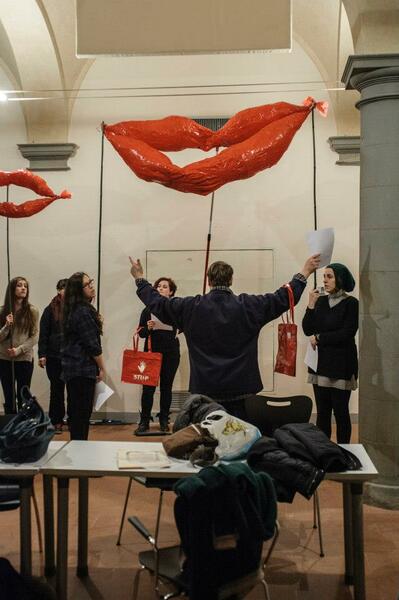 Stop The Violence: Community PerformanceWith many years of work and trust behind us, I was able to give full authority to puppet master Bernard Vandal to work with youth and community members in order to create the visual effect he sought at the event.
Stop The Violence: Community PerformanceWith many years of work and trust behind us, I was able to give full authority to puppet master Bernard Vandal to work with youth and community members in order to create the visual effect he sought at the event. -
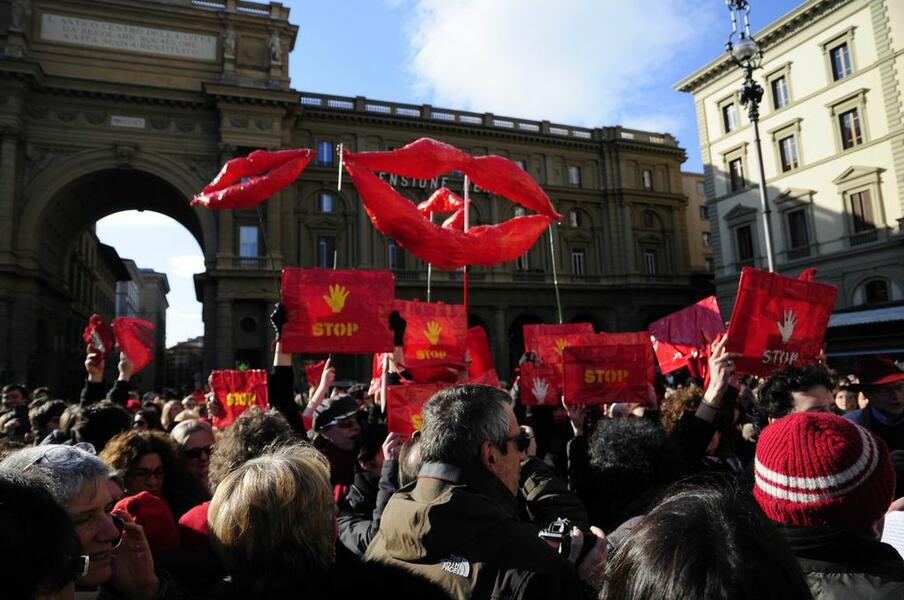 Stop The Violence: Community PerformancePiazza Repubblica protest began with the entrance of the puppets - large red mouths that moved as the artists walked through the crowd.
Stop The Violence: Community PerformancePiazza Repubblica protest began with the entrance of the puppets - large red mouths that moved as the artists walked through the crowd. -
 Stop The Violence: Community PerformanceOur choreographer, Gina Lamparella, can be seen in the upper right hand corner leading the dance.
Stop The Violence: Community PerformanceOur choreographer, Gina Lamparella, can be seen in the upper right hand corner leading the dance. -
 Stop The Violence: Community PerformanceWe had anticipated 500 individuals. 3,000+ was the estimate from the news outlets that attended.
Stop The Violence: Community PerformanceWe had anticipated 500 individuals. 3,000+ was the estimate from the news outlets that attended. -
One Billion RisingI am including this compilation video by Alessandra Barucchieri, one of the participants in the event because it demonstrates the multiple people involved, the creativity and expression it brought, and the power of community that occurred. This form of work has become an aspect of my own creativity which I value - how I construct opportunity for relationships which inspire connectivity to issues greater than ourselves is a creative question for me. Where an empty piazza fills with dance and joy in a collective moment of belief that we can effect positive change empowers me to deepen my community work and further develop and hone my approach to it.



